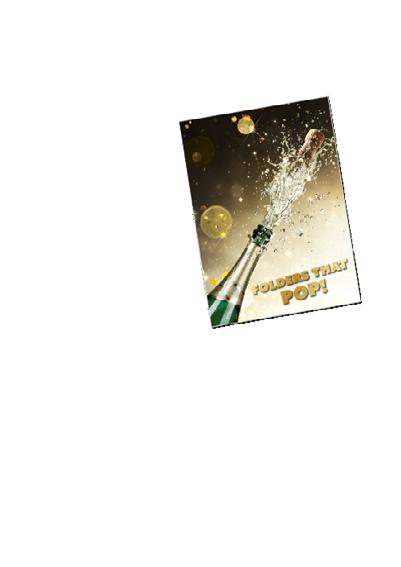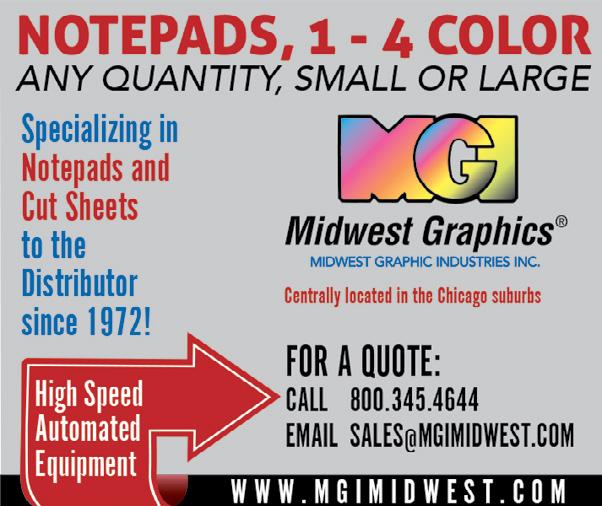TECHNOLOGY OUTLOOK



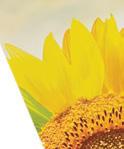













































































































As everyone was aware, 2024 was a drupa year which always means new technologies. And while there may not have been any truly revolutionary new developments that debuted at the show (like digital printing, production inkjet printing, or JDF), the evolutionary technologies and new products on display were just as impactful and are just as likely to transform the industry over the next four years— or until the next drupa.
The next major event is PRINTING United in September, so in this interstitial period between the two shows, this issue will look back at some of the major developments that were on display in Düsseldorf, and ahead to what to look for in Las Vegas. We should point out at the outset that a hefty portion of the articles in this issue appeared in some form in the drupa show daily, which, as we suspect a fair number of people know, WhatTheyThink produced. In addition to live coverage of specific product announcements, purchases, or other news, we had also had our contributors write some overall “analyst” articles that were intended to serve as a guide to approaching different classes of equipment from a potential buyer’s perspective. What is the current landscape is, what questions should you ask vendors, who some of the major players are, etc. These articles were designed so that they would be valuable references for any printer going to any show and looking to invest in a particular class of product. While these were written with drupa in mind, since the show, our writers have added any post-show updates and are intended to serve as guide to attending PRINTING United or any other industry event—or even just doing your own research. And since this is a Technology Outlook issue, the emphasis is on the new technologies that are driving the new equipment hitting the market.
This issue is grouped into eight “themes”:
• labels & packaging
• sustainability
• display graphics
• new & emerging technologies
• inkjet printing
• offset printing
• binding & finishing
• software & workflow
In each theme section, our analysts look at some of the major trends and technologies driving them.
We will also be presenting our complementary Technology Outlook Week of webinars, August 12–16. For a complete schedule and to register for any or all sessions, please visit whattheythink.com/webinars .
Complementing the “sustainability” section, Pat McGrew spoke with Jonathan Graham, Marketing Director for palamides, about preparing for sustainability regulations and the challenges of “net zero” solutions.
This issue also includes the latest installment of our “Tales from the Database” series, this time looking at technology investment trends, culled from our historical database of Print Outlook surveys.
David Zwang talks with Mark Subers, President of Exhibitions and Events for the PRINTING United Alliance, about what to look forward to in Las Vegas next month.
Joanne Gore takes a close look at 10 technological developments that are transforming the printing industry.
We also compiled a roundup of some of the major news announcements that came out of drupa.
Finally, Johnson’s World rounds up some winning mail pieces that caught his attention.
So, without further ado, adieu, and welcome to the Technology Outlook issue!


MANAGING EDITOR
Richard Romano
PRODUCTION
EDITOR, CONTENT
DEVELOPMENT
Amy Noble
SENIOR EDITOR
Cary Sherburne
SENIOR EDITOR
David Zwang
CONTRIBUTORS
Pete Basiliere
Elizabeth Gooding
Joanne Gore
Jonathan Graham
Patrick Henry
Steve Johnson
Pat McGrew
Mary Schilling
Ralf Schlözer
Mark Vruno
PRESIDENT Eric Vessels
CEO Thayer Long CTO Adam Dewitz
SR. VP, CONTENT & PROGRAMS
Julie Shaffer
CLIENT ENGAGEMENT & PROJECT
COORDINATOR Debbie Papineau
ACCOUNT EXECUTIVE
Adam Goldman
ACCOUNT EXECUTIVE Stephanie Papp
QUESTIONS?
Comments? High fives because we’re awesome? whattheythink.com/hello
WhatTheyThink is the global printing industry’s go-to information source with both print and digital offerings, including WhatTheyThink. com, WhatTheyThink Email Newsletters, and the WhatTheyThink magazine. Our mission is to inform, educate, and inspire the industry. We provide cogent news and analysis about trends, technologies, operations, and events in all the markets that comprise today’s printing and sign industries including commercial, in-plant, mailing, finishing, sign, display, textile, industrial, finishing, labels, packaging, marketing technology, software and workflow. WhatTheyThink (ISSN 2642-3189) (USPS 500-850) Volume 47, Number 4 is published six times per year in January/February, March/April, May/June, July/August, September/October, November/December by WTT Media, Inc., at 2038 Ford Parkway #218, Saint Paul, MN 55116. Periodicals postage paid at Saint Paul, MN and additional mailing offices. POSTMASTER: Send address changes to WhatTheyThink, 2038 Ford Parkway #218, Saint Paul, MN 55116. Subscriptions: Individual subscriptions are available without charge in the U.S. to qualified subscribers. Publisher reserves the right to reject nonqualified subscriptions. Annual subscription prices in the U.S.A $95; Canada $125 USD; all other countries $150 USD. Printed in the USA. Copyright © 2024 WTT Media, Inc. All rights reserved. No part of this publication may be reproduced or transmitted in any form or by any means, electronic or mechanical, including photocopy, recordings or any information storage or retrieval system, without permission. WTT Media Inc. does not assume and hereby disclaims any liability to any person or company for any loss or damage caused by errors or omissions in the material herein, regardless of causation. The views and opinions in the articles herein are not those of the publishers, unless indicated. The publishers do not warrant, either expressly or by implication, the factual accuracy of the articles herein, or of any views or opinions offered by the authors of said articles.
BY RICHARD ROMANO
Drawing on six years’ worth of Print Business Outlook surveys, our “Tales from the Database” series looks at historical data to see if we can spot any particular hardware, software or business trends. This issue is our Technology Outlook, so I rounded up some technology outlook-related (or at least adjacent) challenges and investments, as well as our periodic question about the extent to which print businesses are looking to expand into new product areas.
These surveys form the basis of our annual Printing Outlook reports, the most recent of which (2024) is available online now.
Purchase the Printing Outlook 2024 Report
In every survey, we ask a broad cross-section of print businesses about business conditions, business challenges, new business opportunities and planned investments. In our Business Outlook reports, we tend to focus (obviously) on the most recent survey data, occasionally looking back a survey or two to see how these items have changed in the short-term. Plumbing the depths of our survey database can give us a better sense of how these trends have changed since the mid-2010s.
A challenge that has appeared on every survey— and even those going back to the old TrendWatch days—is “keeping up with technology.” Looking at how this challenge has been perceived over the past seven years, we find that it is not a major one (in 2023 it was the number 12 challenge and while it has historically been a top 20 challenge, it’s not a top of mind issue. There was a spike in 2019, likely because
our survey was in the field right around PRINTING United, and the run up to the show likely whetted some interest into updating or upgrading some aspects of the plant. The last pre-pandemic year also boasted the best business conditions in recent memory, so shops had all that much more reason to be looking at new technologies. The challenge has peaked in the last two surveys, and we suspect a lot of that is not necessarily hardware-related; 2022 was when DALL-E and ChatGPT emerged, putting AI on everyone’s radar—and if there was one technological change that could be seen a challenge, AI would be it. No one is still entirely certain where it will end up. There other aspects to print business software that could be challenging, as well—such as even just using print business software.
"Keeping Up with Technological Changes" as a Business Challenge
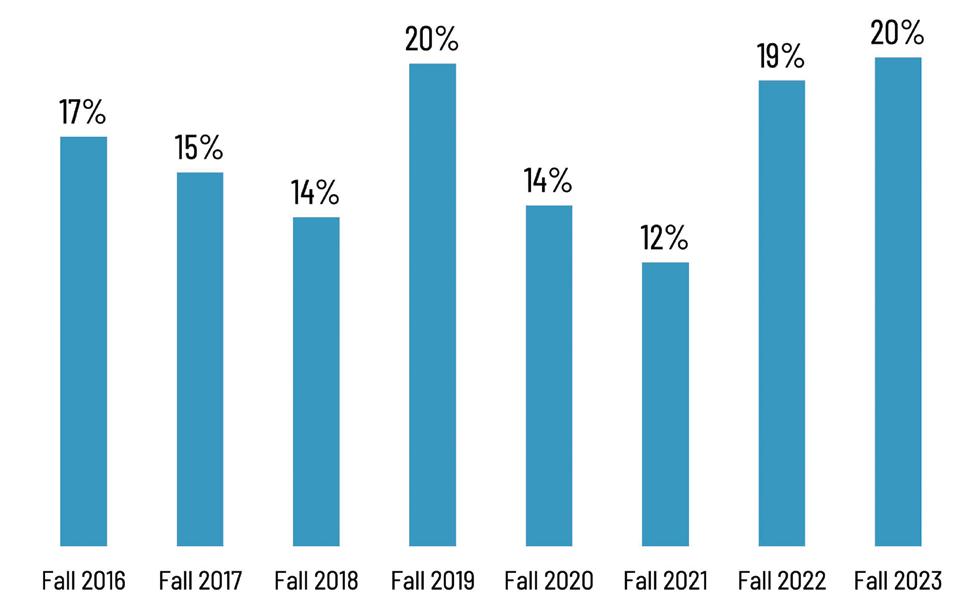
WhatTheyThink Print Business Outlook Surveys, 2016–2023
The top planned investments from our most recent survey (Fall 2023) show a great interest in post-printing equipment—binding and finishing (for digital and analog equipment) and mailing—as well as software. I took the top six items and plotted them back to 2019 to see how the product categories ebbed and flowed. (I would have liked to do more but then I would need to output the chart on a wide-format printer.) Finishing equipment for both digital and analog has been a hot area, but finishing for offset/ analog had a bit of a growth spurt in 2022; as Patrick Henry points out later in this issue, offset printing is very much alive and well and modern presses have made offset more and more competitive with digital—even production inkjet. Workflow automation
High-end flatbed printer
3272 ft²/h output
10 colour channels
Latest print head technology
126” wide roll option
Greenguard Gold certified ink
Meet us at Printing United Expo, Las Vegas, NV, September 10 – 12, 2024, booth C2375


High-end UV-LED printers
Engineered and manufactured in Switzerland

WhatTheyThink Print Business Outlook Survey, 2023
Selected Planned Investments—2019-2023
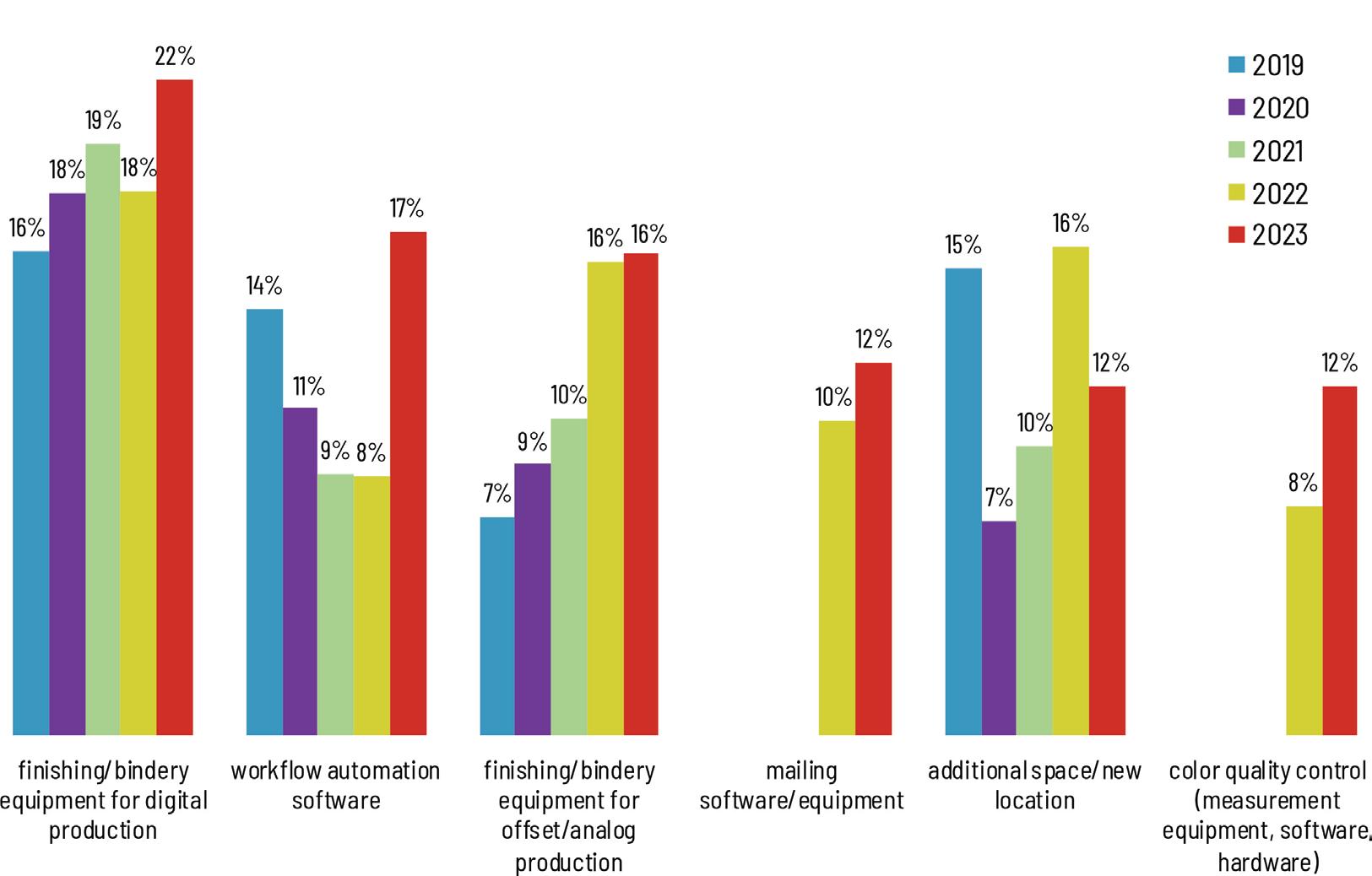
WhatTheyThink Print Business Outlook Surveys, 2019–2023

software dropped to its lowest ebb in 2022, but spiked to its zenith a year later. We added “mailing software/equipment” in 2022 after noticing it had been a big write-in response in the prior couple of surveys, and it has only become more popular. “Additional space/new location” spiked in 2022—by that point, it was possible to determine if the effect of the pandemic would require a bigger location to expand capacity/capabilities or a smaller location that needed only a shop floor as work from home precluded the need for what Jen Matt used to call “the carpeted areas of the business.”
And, yes, I also tracked the “we have no planned investments” responses during this same period:

“We have no planned investments” was up a bit in 2023, and for a basic reason: 2023 was a lousy year for capital investment as high interest rates made any financing costs prohibitive, or at least worth putting off until rates come down (we can tell because
“financing costs of our equipment” came in at an all-time high in the Business Challenges question). Naturally, this doesn’t apply to things like software, but any major equipment purchases will likely be put off until rates come down unless it’s an emergency.
Every few surveys, we try to gauge the extent to which print service providers are branching out into new product and service areas, if they had already added those new products/services, and, if not, if they had a time frame for adding them—or if they were even on their radars at all.
So where do print businesses see their growth areas? Production inkjet and folding carton printing (and the two are not mutually exclusive) appear to be the areas in which printers look to be expanding. Display graphics had been the hot application area 10 years ago, but everyone who was ever likely to get into display graphics has already done so. Textile and other specialty printing—especially décor—have been touted as hot growth areas, but they have not turned up in our survey data, or at least not yet.
Dr. Joe Webb used to say that printers ignore a new technology until they start losing business to it. I’m not sure that’s the case anymore, and printers across the board have come to realize that diversification is a major strategic plan in today’s industry.
But technology doesn’t just mean adding new printing capabilities, but also modernizing the business in general. And that more often than not means software. Which means keeping up with technology—or perhaps catching up with technology when it becomes necessary. WhatTheyThink Print Business Outlook Surveys, 2019–2023
BY DAVID ZWANG

Mark Subers President of Events and Expositions for PRINTING United
drupa 2024 was a successful event according to exhibitors and attendees. It looks like this success will carry over to PRINTING United 2024 being held in Las Vegas, NV September 10-12, at the Las Vegas Convention Center. While they are both big events, they are different.
PRINTING UNITED EXPO
September 10-12, 2024
Las Vegas Convention Center | Las Vegas, NV https://www.printingunited.com/
Industry events like drupa and PRINTING United are an important resource for exhibitors, but even more so for print and packaging service providers. As we look at the continuing print industry transformation, and all that is driving it, the questions are many and so are the opportunities. I recently had an opportunity to speak with Mark Subers, the President of Events and Expositions for PRINTING United.
WhatTheyThink: Mark, you attended drupa. What were your observations?
Mark Subers: It was crazy, and that's really good. R&D cycles are moving on an annual basis now because digital’s development and acquisition are moving faster, and even analog developments are moving faster. Of course, the technology around some of the software advancements and workflow are also moving faster and playing a more important role in the minds of service providers. There were a lot of new developments at drupa, but the first time many will have an opportunity to see them be in the Americas at PRINTING United, so if people didn’t have the chance to get to Germany, this is a very important event.
There were a lot of exciting things is that I was trying to capture from drupa. I was able to meet with a lot of the North America marketing teams since they were not as busy as the European teams. Of course my question to them was, so with all the gear here, what's coming to the states and PU? What I heard was that some of the things that were at drupa are literally getting boxed right up and shipped right to Vegas.
MS: You know, there's always three legs of the expo stool. It's education, it's peer to peer and then it's the equipment, although the equipment is overwhelmingly what people come to see. Realistically, we're not going to have the breadth and depth of drupa because they're an every four years show and cover a much broader range of applications, and that’s why drupa has that pull. However, we are going to see the key new pieces of technology coming to PRINTING United, and maybe some other surprises.
We were known as the wide-format show, and we really jumped on production wide-format inkjet, and mistakenly didn't pay attention to the roots of screen printing, which were deep in our roots in the Specialty Graphic Industry Association (SGIA). When we started to expand and look toward technology and convergence opportunities for print service providers, with the increase in digital textile print, we are now reengaging them, resulting in a growing segment of the exhibition.
As we have in the past we are also starting to grab the attention of the digital label and packaging folks. While we are not a label or packaging show, we're arcing in that direction where we've had critical mass of solutions in the past events, plus other convergent opportunities that they might want to come and see. That’s how we grew from the 98th largest expo in North American to the 29th largest. And last year we won the best return on investment from any expo in the top a hundred. And that includes CES and everybody else.


WTT: The last two years have seen the event continue to grow, so what can we expect this year in Las Vegas?
MS: We are historically a North American show, which of course includes Canada. However, with the purchase of Graphics of the Americas, we are pulling all those audiences up from the Caribbean, Mexico and Central and South America. So while drupa is primarily a European show, we are trying to be the show of the Americas. I do think that exhibitors understand that and are trying their best bet to get in front of the largest print market. Of course, that means that the attendees also get the benefits associated with that exhibitor turn out.
The Vegas Convention Center is normally about 1.2 million square feet, but it is under construction so we are limited to space this year. This year, we are expecting over 800 exhibitors. The South hall has been totally filled out with the DTG (Direct to Garment), wide format, apparel and industrial exhibitors. Limited space is also a problem we're going to face for 2025 because, while we probably have 1.1 million square feet this year, we're running out of space. When we go to Orlando next year, we only have about 950,000 square feet, which sounds like a big place, but it's not. We're really going to be wall-bound in Orlando. So we're really trying to make that point to the exhibitors. We've already started our presale for 2025, and we've already got almost 200 exhibitors signed up for that. Our guestimate is that there could be 150 exhibitors on the outside looking in. We're just not going to have the space for them. In 2026 we are in Atlanta with about 1.3 million square feet, and space availability will be better.
WTT: At drupa there was an announcement that Messe Düsseldorf and PRINTING United were exploring opportunities. What does that mean?
MS: We have been talking with each other for years about how we can best support each other. I think we are now trying to take that to the next level. As it stands today, there's nothing we have decided other than we've decided we want to try to work something out. I'd love to see us get very deeply seated together. And I think that benefits everyone. Our expertise, combined with their expertise could be synergistic and powerful. Drupa has been the international show for decades. However, they recognize that we are the guys in North America, and have found a model that works well. Time will tell how this all shakes out.
WTT: What about the future?
MS: What we've been able to do in the last four to five years, merging PIA, IdeaAlliance, Graphics of the Americas, buying media, and bringing a whole new model to market, and making it happen successfully, has been quite a ride. I think now we're starting to look what a PRINTING United Alliance 2.0 would look like. What do we do in the next five years and who can we align with and partner with to make that a reality? And then just keep advancing.

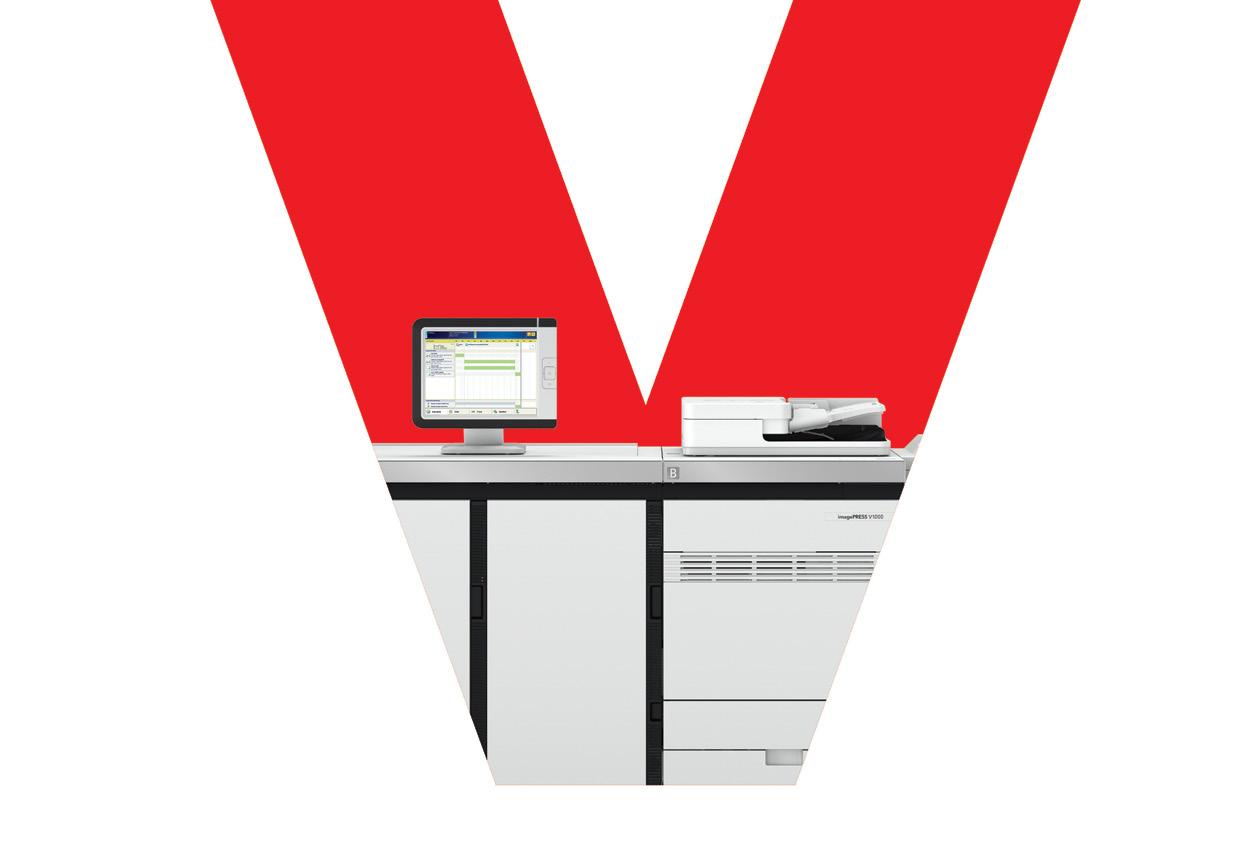


The imagePRESS V Family of color production digital presses elevate the proven quality, productivity, reliability, and versatility of the imagePRESS brand. With Canon’s dynamic combination of integrated color control and distinct, vital technologies,
the imagePRESS V Family offers outstanding, laborsaving automation that can help even the most novice operators deliver superb, impressive output easily and efficiently. And it’s exceptional results like these that can keep your customers coming back for more.
PATRICK HENRY, RALF SCHLÖZER, CARY SHERBURNE, AND DAVID ZWANG CONTRIBUTED TO THIS ARTICLE.
With drupa 2024 in the rear-view mirror and PRINTING United on the road ahead, here are some of the major announcements that came out of Düsseldorf, and a hint of what will be on display in Las Vegas.
There is still a considerable opportunity for digital production print in the B2 format, by moving short runs from offset to digital, by consolidating EP volumes, or by opening new opportunities in on-demand print. At drupa 2016, Canon showed the Voyager, a prototype B2 inkjet press. Since then,
Canon collected customer feedback on a B2 inkjet press and it seems that the efforts paid off and culminated in the launch of the varioPRESS iV7. A key for a competitive inkjet press is productivity. For one, the varioPRESS iV7 has a speed of 8,700 impressions on a B2 sheet per hour or 4,350 sheets in duplex print. With a larger sheet that supports 6-up impositioning (614 x 675mm/24 x 26.6-in.), the speed drops to 7,200 impressions/hour, equating to 720 A4 ipm (in 6-up). Additionally, the iV7 has been designed for high availability and includes productivityenhancing features like multiple paper trays and automated quality control.
Other features position the iV7 equally well for the commercial market. Uncoated paper from 60 to 450 gsm and (standard) coated papers from 75 to 450 gsm are supported, which includes light board. With a 1,200 dpi printing resolution and multi-level drop sizes, the press aims for a high print quality.

The new varioPRESS iV7
By naming the new product varioPRESS, instead of varioPRINT, Canon makes it clear that the varioPRESS iV7 is targeted at highvolume environments. The press was not exhibited live at drupa, but visitors could watch a virtual presentation, including print samples and a video of the press operating at the Canon R&D facility in the Netherlands. Availability is planned for the second half of 2025.
The iV7 press follows the unit design of an established digital press. Sacrificing a compact footprint opens up several advantages, however. Besides the high-stack feeder, up to two paper tray modules can be added. This allows instant switching of papers or mixing papers in a job and users can load a new paper while the press is printing. Another advantage is a straight paper path—the sheets travel the whole length of the press in one plane, avoiding bending. Only when duplexing, the sheets are fed back at the bottom.

Interestingly Canon is using a new type of printhead in the press, the Canon Production Printing piezo inkjet head. This contrasts with the Kyocera piezo heads used in the web models and the varioPRINT iX. The heads are recirculating to improve nozzle health
The iV7 is a major step forward for Canon in inkjet technology, featuring a new press platform and inkjet heads. It could be stepping stone for Canon’s ambitions in packaging print. Also, a 7-color version and added in-line finishing could follow. The iV7 more than doubles the speed compared to the iX-Series and, as a result, is closing the gap to the continuous feed models while giving high-volume users a choice between a web and cut-sheet workflow.
During a press conference at drupa, Canon, announced a global sales and service co-operation in inkjet printing with Heidelberger Druckmaschinen. The agreement will see the varioPRINT iX3200 B3 sheetfed inkjet press and the newly announced varioPRESS iV7 B2 sheetfed inkjet press (see above) integrated into Heidelberg’s commercial print portfolio. The products will be sold via Heidelberg under their own brand and product names.
Canon also announced new additions to its hardware and software solutions in addition to the varioPRESS iV7, including the new varioPRINT iX1700 sheetfed inkjet press, which will produce average monthly volumes from 300,000 to 1.5 million A4 images. The new press is positioned between the varioPRINT iX3200 B3 sheetfed inkjet press and the imagePRESS V series of color toner presses; the new ProStream 2000 series and the ColorStream 8200, designed for ultra-high volume inkjet applications; the Arizona 2300 FLXflow flatbed wide-format printer with optional PRISMAelevate XL software; new imagePROGRAF PRO and GP series of large format printers; the next generation of Canon’s large-format technical documentation systems: the plotWAVE and colorWAVE T-series; multiple innovations to expand the range of high value applications PSPs can develop with the Colorado M-series to support their business growth, including the new UVgel Packaging Factory, FLXture which adds microtexture to print surfaces and the capability to print graphic overlays for membrane switches; the new LabelStream LS2000 water-based digital label press; its concept for a 1.7m wide, single-pass, industrial-scale corrugated press (shown via a 3D model), offering a production speed of 8,000 sq. m/hr. at offset quality; and Edale’s FL5 carton production line integrated with FDC6000 flatbed die cutter for single-pass carton embellishment and finishing (Edale has been a Canon company since 2022).
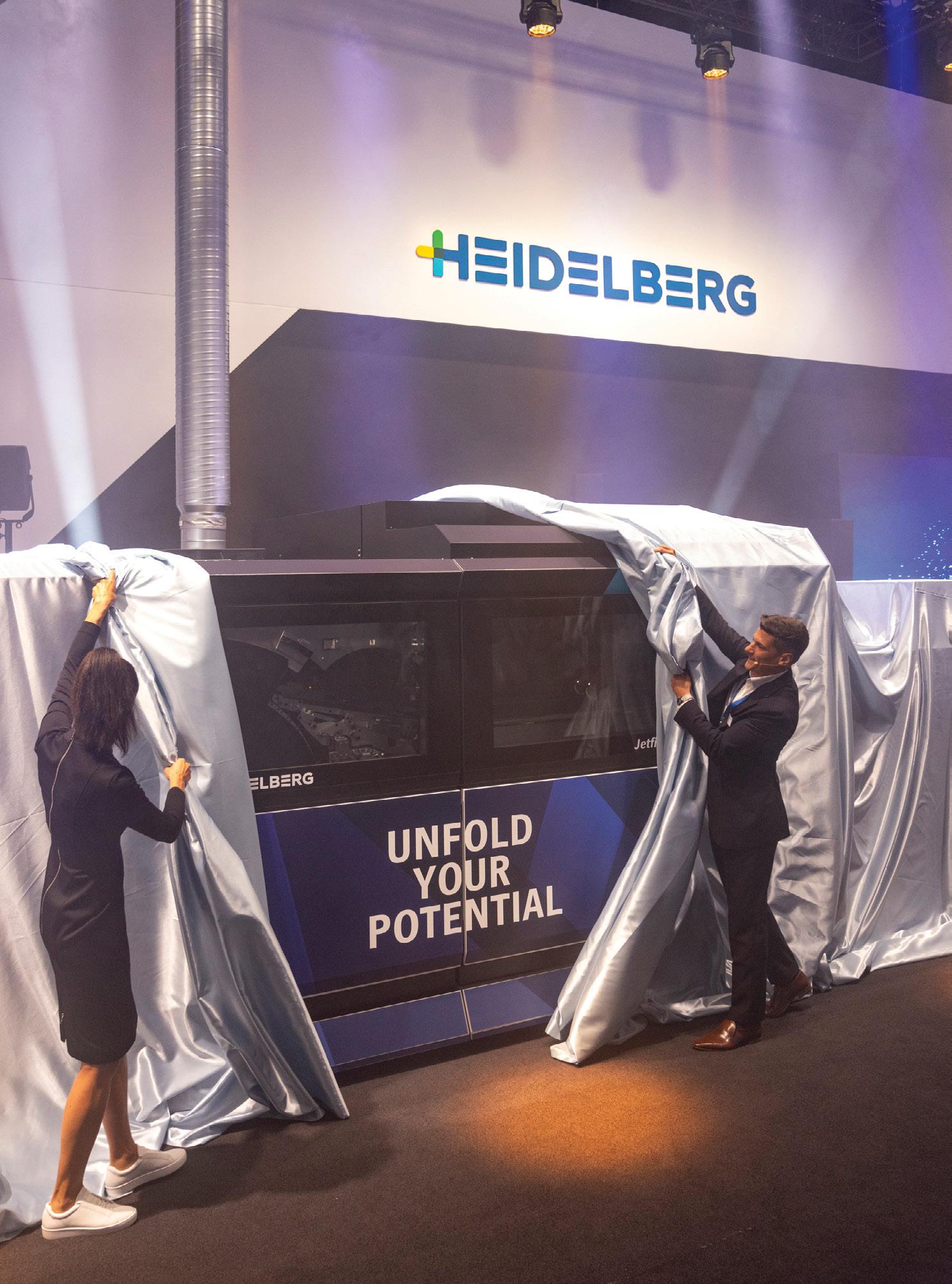
Heidelberg’s central product announcement at drupa was its return to industrial inkjet printing with a pair of machines introduced in partnership with Canon (see above for an overview of Heidelberg and Canon’s partnership).
They are the Jetfire 50 in B3 format and the Jetfire 75, a B2 press. Heidelberg is promoting them as solutions for hybrid production in combined offset and digital environments where both processes can be linked together in the latest iteration of the company’s Prinect workflow.
The Jetfire 50, based on an existing Canon product, is said to be capable of printing more than 9,000 SRA3 sheets per hour for an annual output of 60 million sheets per year. It is designed for runs of one to medium volumes at 1,200 x 1,200 with a minimum of operator touchpoints. Deliveries are scheduled to begin in the first quarter of 2025.
Based on a newly announced B2 platform from Canon, Jetfire 75 is targeted at commercial products such as brochures, books, posters, and banners. Its claimed output is 8,700 sheets per hour for 54 million sheets annually. The 1,200 x 1,200 press, according to Heidelberg, is twice as productive as other equipment in the B2 digital category. Delivery is anticipated to start in early 2026.
Heidelberg will provide singlesource service and support for the Jetfire presses. Both are designed for integration with Prinect, Heidelberg’s hybrid production workflow. New at drupa was Prinect Touch Free, an AI-enhanced solution designed to guide large numbers of jobs through production with maximum efficiency.
Prinect Touch Free has three elements—Pathfinder, Decision Maker, and Auto Scheduler—that calculate output options, choose and initiate the best ones, and adjust production as necessary during the run. The cloud-based solution is designed specifically for hybrid printing environments, says Heidelberg.
On the offset side. Heidelberg was showcasing the latest generation of the Speedmaster XL 106, which was being demonstrated at their stand in live runs up to 21,000 sph. Heidelberg says that its Push to Stop technology for autonomous operation eliminates 98% of the manual touch points associated with high-volume offset production.
Heidelberg also is promoting Boardmaster, a flexographic press for high-volume folding carton work. Boardmaster can change sleeves while running at up to 600m/min. (2,000 fpm) for uninterrupted output.
At drupa, Koenig & Bauer was promoting a long list of product innovations aimed at upholding the distinction it claims as a manufacturer that can apply any printing technology to any relevant substrate. Many of the presentations at the show highlight its developmental relationships with other providers of solutions for the print markets it serves. The show lineup in brief comprised:
• A joint venture with Durst has created the VariJet 106, a B1-format digital inkjet press for one-pass printing in high-volume folding carton applications. Currently in beta test at three customer sites, the VariJet 106 prints in seven colors of water-based ink and can be configured with additional offset, flexo, and coating units.
• Koenig & Bauer was showing various applications for the RotaJET digital inkjet web press, emphasizing digital decor printing and high-volume packaging production.
• Live demonstrations of the Rapida 106 X took the offset press to its rated top speed of 22,000 sph, claimed by Koenig & Bauer to set a new industry benchmark.
• The main application focus for the XG and XD Pro models of Koenig & Bauer’s CI flexographic presses will be biodegradable film products for food packaging.
• Koenig & Bauer calls MetJet ONE, another joint development with Durst, the first digital metal decorating press.
• In postpress, the offerings included the world premiere of the CutPRO X 106 rotary diecutter for folding cartons; the CutPRO Q 106 SB flat-bed diecutter; the ChromaCUT X Pro and ChromaCUT High Tech 2S diecutters for corrugated; and the Omega Alius 90 folder-gluer.
• An important new development in software is myKyana, a portal that lets Koenig & Bauer customers access a suite of tools—Kyana Connect, Kyana Data, Kyana Assistant, and Kyana Campus—for peak operating efficiency.
• PrintFusion is a new gateway to control Rapida presses in conjunction with the prepress software PACKZ in the CLOUDFLOW production workflow.
The company also has woven sustainability and workforce development into its drupa program. Under the eco heading, Koenig & Bauer offers its customers a “Product Carbon Footprint Calculator” to help calculate the carbon emissions attributable

to sheetfed offset production. For education, the Koenig & Bauer Academy is being presented to visitors as an all-inclusive concept for qualification and further training opportunities.
New introductions at drupa are a given, but usually they are spread across multiple exhibitors. Fujifilm has taken that to an extreme.
The long awaited 50m/min. FP790 aqueous-based flexible packaging press is a hit with converters since it fills the need for indirect food contact.
Fujifilm also introduced line extensions and upgrades to their Revoria line of toner presses that include the new GC12500, the first and only toner press that brings B2+ digital printing to an affordable level.
Additionally, they launched four new mid-range production presses in the Revoria PressM series including the Revoria Press EC2100S and Revoria Press SC285S, which are equipped with a specialty toner station in addition to the four CMYK color toners, enabling five-color printing in one pass. These join the flagship Revoria Press PC1120 sixcolor print engine that supports up to two specialty toners, at a resolution of 2400 dpi. A variety of specialty toners are available in Clear, Pink, Custom Red, Gold, and Silver.
In the wide-format space, the new Acuity Triton now uses AQUAFUZE ink technology which combines the benefits of UV LED and water-based inkjet. It has low-energy, low-temperature drying compared to traditional water-based print systems and provides excellent adhesion to a wide range of media without the need for a pre-coat primer or optimizer.
At drupa, they also showed the Jet Press 750S, the latest version of their B2 sheetfed inkjet press now operating at 3,600 sheets per hour in High Quality mode and 5,400 sheets per hour in High Performance mode. If that’s not enough, they were also showing the 1160CFG continuous-feed inkjet printer operating at 160 mpm, with the new paper stabilizer which improves ink drying on thick paper and reduces waviness on thin paper due to the presence of moisture.
Perhaps the biggest announcement from Fujifilm was the new Fujifilm Dimatix SkyFire SF600 printhead. Like its predecessor, the Samba, this new printhead leverages their proprietary piezoelectric inkjet technology based on proven silicon Micro Electro-Mechanical Systems (Si-MEMS) fabrication techniques. It is designed to withstand a wide variety of inks including aqueous, organic solvents, and UVcurable, and print at high speeds while offering high quality and durability.
The SkyFire printhead can deliver four gray levels at 600 dpi resolution with a drop size range of 5–25pL and nozzle layout that enables a high throw distance to meet a broad range of applications. It is designed to support applications including commercial packaging, decor, textile, printed electronics, imprinting and coding and many others.

The printhead can jet an impressive 11 grams of ink per square meter per color at over 130 meters per minute with four levels of grayscale. OEMs can benefit from Versadrop open waveform editing capability that enables them to tune printhead performance to their specific application.
The EFI family of Nozomi single-pass directto-corrugated printers continues to expand. The company has brought multiple versions of the printer to market since it first debuted at drupa 2016, including 1.4- and 1.8m wide printers customized for corrugated printing as well as models customized to the display graphics market.
Nozomi represents a transformative technology for increasing printing capabilities and crafting new business models. Its image quality turns plain boxes into colorful brand magnets. And it’s sustainable as well—reducing waste, speeding time to market, and using genuine EFI packaging inks, UV LED curable reducing energy requirements. EFI Nozomi LED inks for corrugated packaging are GREENGUARDand GREENGUARD Gold-certified, meeting UL’s rigorous standards for low-level emissions of volatile organic compounds (VOCs) intended to reduce indoor air pollution and the risk of chemical exposure. They also meet OCC-E certification for reliability and recyclability (testing performed in the US and EU at Western Michigan University and Fachgebiet fur Papierfabrikation and Mechanische Verfahrenstechnik [PMV]).
The latest member of the Nozomi family is the Packsize EFI X5 Nozomi developed in partnership with Packsize, the industry leader in right sized, on-demand packaging technology, tailoring custom sized cardboard boxes for every product. Rightsizing boxes optimizes space and results in a 40% reduction in boxes, 60% less void fill, and a 26% decrease in corrugated material, significantly saving on materials and shipping costs.
Corrugated fanfold or Z-fold material is fed into the system, it’s cut to the right length, digitally printed, variable die cut/cut, glued and erected all in line, in about six seconds. The box is exactly the right size for its contents as it can be driven seamlessly from a MIS/ ecommerce system using Packsize’s PackNet software. Each box can be different—different graphics, a different size, fully decorated for the ecommerce or big box store environment—and all automatically driven without an operator, greatly reducing labor costs and creating a true on-demand system.
This breakthrough in customizable packaging offers a transformative approach to addressing the surging demand for right-sized, eco-conscious packaging solutions and leverages the proven Nozomi performance.


HP and Canva announced that they will join forces in a groundbreaking collaboration to provide unique design-to-print services and experiences for over 185 million monthly Canva users with HP Print Service Providers across the globe.
This global multi-year partnership aims to deliver an accessible, scalable, and sustainable printing experience to a larger Canva customer base worldwide with localized printing options. By using HP PrintOS Suite automation, this will accelerate onboarding and ramp up new print volume to HP’s integrated network of PSPs.
Canva, founded in 2013, has over 185 million monthly users, including 95% of the Fortune 500. The launch of Canva Print in 2017 has allowed users to design and print a wide range of products, including business cards, brochures, flyers, stickers, marketing collateral, with customization options, and even apparel. This collaboration will also utilize the extensive global network of HP Industrial Print and HP Large Format to drive volume to HP-equipped Print Service Providers, delivering the widest range of print to Canva users.

HP PrintOS Site Flow will help Canva extend its reach by automating production and shipping processes for PSPs. This end-to-end solution streamlines print jobs with auto-scheduling, delivering color consistency, security, barcode tracking and optimal productivity. Additionally, HP’s expansion of its PrintOS Suite with new features will equip the Canva Print Operations team with powerful tools to identify, connect and manage a global SKU catalogue across HP-enabled PSPs.
This new collaboration between HP and Canva also aligns with their shared commitment to sustainability enabling teams to effortlessly create impactful visual content with a reduction in its carbon footprint through localized operations.
Landa Digital Printing and Gelato, announced a collaboration that leverages Landa’s Nanographic print technology and customer network, and Gelato’s global software platform—GelatoConnect—for the delivery of on-demand, short-to-medium run, digitally printed jobs.
Utilizing Gelato’s robust fulfillment network, present in more than 32 countries, digital print partners also benefit from streamlined workflows, enhanced market reach, and a shared commitment from both companies toward enhanced sustainability.
Gelato is a software company that enables a digital print on-demand facility to significantly improve endto-end production efficiency. GelatoConnect allows a single print facility to compete effectively with the old traditional and legacy bound manufacturing facility with local, on-demand production on a global scale through the world’s largest network for production on demand.
Most of the major press announcements at drupa focused on hardware, but drupa 24 was very much a software-centric show; see the Software & Workflow section of this issue on page 60 for a taste of what was on display. Software is playing an increasingly big role in today’s print production workflows. For WhatTheyThink’s complete drupa coverage, visit https://whattheythink.com/topic/drupa/
Look for more software announcements and products at PRINTING United. Get more info and register at https://www.printingunited.com/.


changeover process and ensures the highest levels of productivity. The functions could also include setting up the equipment based on predefined rules and input data from preceding processes.
Here are some examples that were on display at drupa.
While Packsize right sized corrugated box making has been around for a while, the Packsize EFI X5 Nozomi can print and produce up to 600 different size boxes inline per hour.

The KAMA FlexFold 52i folder-gluer automatically adjusts itself up for the box dimensions of the next order. The feeder, pre-folder, gluing disc, and the entire folding and gluing section are motorized and move automatically to the correct positions (KAMA patent). This makes job changes possible in less than
Available with varying degrees of automation and connectivity, the Heidelberg Diana Easy folder gluer is available in the format range of 85cm and 115cm (33.46 in. and 45.28 in.) and can easily handle products with a maximum product length of 600mm. Cartons of 200–600 g/m² and up and an E-flutes of corrugated material can also be processed.
The Heidelberg FCL series flatbed die cutter can combine cutting, creasing, embossing, and window and outer contour punching. It is driven by servo technology with no format gears, and the feed roll unit is connected to die-cut head for precise control. It also includes a sheet separator and supports transport unit adjustment during production. The stripping drum is adjustable in and across the
The KOLBUS Boxmaker machines for 1- to 3-flute corrugated board can be used for the automated production of various packaging sizes and type according to FEFCO catalog of box styles. It offers easy operation, fully automatic settings with short set-up times.
Based on discussions and experience, this type of adoption is usually done in stages, since adaptation to existing processes requires more attention. Companies usually start with the hardware first and they bring in the software over the top. The workflow system is ultimately the umbrella over all of the hardware solutions. Many of the equipment manufacturers are now offering integratable software solutions that are even starting to move to the cloud. This can add future proof growth and value add machine learning and reporting services.
BY DAVID ZWANG
Flexo continues to be the most cost-effective solution for mid- to long-run printed packaging output, driven by the increase in quality and the continued development in digitalization of the flexo press equipment. Developments include inks, anilox rollers, plates, ITR sleeves and process automation and control, combined with robotics and an increase in hybrid and purpose-built press configurations all designed to increase quality and to reduce the need for increasingly hard to find skilled labor and to decrease costs and time to market.
Today’s flexo results in extremely high-quality print while still providing high productivity and low cost, with the added benefit of creating a significant defense against electrophotographic and production inkjet solutions. While the basic concepts of flexography have not changed, digital enhancements are affecting everything from transport to imaging and providing significantly enhanced automation and control. In the area of transport, the use of visual and other sensing technologies, combined with digital servo controls, enable less operator involvement and better control. This provides an advantage for flexo in that it can also be configured to address a full production line from precoat (if needed) through printing, embellishment, finishing, etc.
Today, technological developments are at the forefront of all flexo equipment and consumable manufacturers with increased digitalization, automation, and inline finishing enhancements to reduce costs and to address changing market requirements. There is also continued development in addressing environmental concerns for processing waste. Ink manufacturing is providing more ecofriendly inks and manufacturing processes to comply with local and global regulations. Meanwhile, paper and plastics manufacturers are developing substrates and solutions that better fit the reduce, reuse, and recycle model.

The introduction of production inkjet has enabled the imaging engine to decouple from the “standard” transport and in its place become part of a custom or bespoke transport solution. It can stand on its own or be integrated into a manufacturing line, and this adaptability has similarly been mirrored in newer flexo converting equipment. Increased development in digital electrophotography, like the HP Indigo V12, and newer production inkjet presses to address changing consumer demand and mass customization will continue to increase market pressures on flexo in the medium to long term. To help mitigate that threat, and to address the increasing demand for shorter runs, there will continue to be a drive for increased digitalization of the flexographic process. To date, this digitalization has had a positive impact, resulting in the replacement of less productive equipment. That having been said, “all in one” flexo solutions, which were initially designed as lowercost options, requiring more limited skills have been evolving as well. They have been expanding from the initial roll-to-roll design to more complete solutions that could include inkjet printing, flexo printing, die cutting, embellishment, etc. This is mirrored in newer hybrid flexo converting solutions.
So the reality for the short and mid-term will be the coexistence of digital and inkjet with flexo based on volumes and cost. While flexo will still dominate the mid to long run applications, the battle lines are being drawn between EP and inkjet for capturing the shorter-run on-demand label and packaging production along with inline finishing and embellishment. Expect to see this model continue to evolve and capture flexible packaging, folding carton and corrugated boxes.

BY DAVID ZWANG
There is a growing increase in orders for short-run, on-demand packaging to satisfy shifting consumer purchasing requirements and operate at the “speed of retail.” There are also new regulations that dictate the amount of “free space” in a box to reduce packaging waste. Using what has been learned from commercial web2print implementations, there is also a desire to use it for package converter onboarding.
While the B2C and B2B models of implementation and constraints on variability still exist with packaging, converters are finding levels of complexity not seen in commercial print. First, there is no single packaging application or type. Packaging types can include primary, secondary—and even tertiary. Second, there is no single packaging format. Packaging can include labels, flexible packaging, paperboard boxes, corrugated boxes, bottles, cans and beyond.
Web2pack (W2P) shops, both connected to converters or standalone, are acting as transaction engines for a wide range of digital and flexo printed products. They include solutions for labels, folding carton and corrugated packaging and are continuing to expand. Unlike most web-to-print applications and print providers, ordering a box online can be a complex process. After all, a box can take many shapes and sizes. If you are not a packaging engineer how do you create the template, die outline and ultimately, the graphics to fit?
Other awareness complexities include those around safety, product ingredient labeling, track and tracing regulations, as well as anti-counterfeit measures
depending on the product and markets. Converters have expertise in these areas and can guide these small producers, according to Carl Joachim from ePAC, the largest on-demand global flexible packaging producer. Vistaprint, one of the more experienced W2P providers, now offers printing and customer support for labels, cartons and flexible pouch production, and is increasing their presence and offerings.
If you are looking at adding Web2pack package production, there are solutions that vary by market and application, just as they do with Web2Print. Constrained design packaging products usually include a library of label or package types, and are the way most of the successful solutions are developed. Most of the solutions on the market today are subscription-based and include standard templates. They also support open integration and in many cases have existing support for shop systems.
CloudLab (see sidebar) offers Web2print and Web2pack solutions, including packQ, that support multiple storefronts like most of the Web2print software solutions. It includes a template platform with an advanced 3D editor. It also has extensive API support to integrate into business and production systems.
PackQ offers a 3D Packaging Designer, a template gallery and a library of folding carton, corrugated and display structures based on parameterized standards and the ability to add vectorized graphics for embellishment of the designs.
If you are not ready for an off-the-shelf constrained design Web2pack solution, you may still need to prepare quotes at the speed of retail and onboard and optimize process orders.
Packitoo (who was partnering with Bobst and Esko at drupa) offers Connect, a solution that provides converters a way to optimize their short run carton production and Packitoo HIPE, a software that can be used for quick quoting of carton production. This software has already been integrated with ARTIOSCAD from Esko, to get the carton dimensional information and use it to determine the pricing on-demand.
Over time, as more of these systems are developed and implemented, and the advantages of machine learning are brought into the development process, the constraints to variability will continue to soften.
The upcoming PRINTING United show will likely also feature Web2pack solutions providers, so if you are heading to Las Vegas and are interested in Web2pack, have your questions ready.
BY PATRICK HENRY
Imagine being a mother of three working at midnight to stock her web-to-print product portal with new designs. This is exactly the kind of customer that CloudLab says it keeps in mind as it builds simplicity into W2P solutions that every printer can use.

The software developer’s clientele include 330 printing companies, among them some of the largest providers in Europe. Its objective is to enable printers of all sizes to quickly create products for their e-commerce customers without the need for IT support or long learning curves.
Two products—printQ and packQ—automate the entire design sequence with tools said to make it easy for printers and their customers to build the
products they want from extensive libraries of visual elements. Once the design is approved, the printer gets a production-ready PDF file along with guidance for pricing the job. CloudLab says the design workflow can be integrated with almost any online storefront through an open API.
printQ features an AI-assisted template gallery to streamline the creation of commercial print products, wide-format printing, labels and stickers, promotional items and textile apparel. Customers see accurate previews and can add vector graphics and embellishments as desired.
With packQ, customers quickly create dielines from a library of 120 folding cartons, 290 corrugated containers, and 50 POS displays, all with various options for flaps and closures. A related database contains 1.4 million images that can be used free of charge. Support for variable data printing and live 3D previews are built in.
CloudLab, whose customers include brand owners as well as printers, also offers plug&print, an entry-level solution for simplified web-to-print/web-to-pack applications.

BY RALF SCHLÖZER
It has been said that we are living in a “parcel economy” since mail-order volumes boomed during the pandemic. While the majority of corrugated boxes have no or little print, brands are warming to the idea of using this real estate for branding or promotional purposes. This will not only drive print volumes in general, it will require higherquality graphics, just-in-time production and even some customization or personalization.
All the requirements point towards inkjet as the dominant technology for these applications. Inkjet is the only digital technology able to cover the formats required in corrugated print. Inkjet can also cope with the uneven surfaces of corrugated boards.
Although inkjet is still relatively new to the corrugated printing industry, there are already plenty of choices. Several types of inkjet printers exist for corrugated and the closely related POS/ display market. In post-print, flat corrugated boards
Feed type Ink type
are used as substrate. This is the most widely used process, typically done by flexo presses today. Inkjet comes in different combinations of productivity and automation, with high-end automated presses and manual feed entry level presses using page-wide inkjet heads. Scanning head flatbed large-format printers can and are producing print on corrugated as well, although possible volumes are much lower.
A second option using offset is preprint. In this case, the top liner is printed separately, before the corrugating (in which the flute layer and back liner are added) and converting operations. Alternatively, the printed sheet is laminated on top of the board. With the AGFA/BHS joint development of an inkjet array inside a corrugator another option is on the way.
The post-print corrugated press market has especially picked up steam recently. Most of the suppliers in the table below have started shipping and more than 100 post-press corrugated inkjet presses have been installed in Europe and North America thus far. Installation numbers for preprint presses are smaller, but they are more productive and expensive.
The range of vendors will expand further with more analog press manufacturers jumping on the digital bandwagon. More products are likely to arrive from China. As it is the biggest packaging market in the world, many inkjet printers from local brands are in use already, but those have scarcely made it to Europe or the US so far. For a wider reach, companies need subsidies or partners outside of China.
The adoption of inkjet in corrugated with single-pass presses is not a sprint, but a long-distance race. Users clearly see the opportunity and the changing demands of brand owners. However, the installations are large and pricey. Above all, they require not only new press technology, they require changes in the business model as well. However, forward looking converters are already preparing themselves for a digital print future.
Typical run lengths
Suppliers
Preprint Roll Aqueous >10,000 sq. m HP
Post-print high end Sheet—automated Aqueous or UV 500–20,000 sheets Barberan, Domino, EFI, Flora, Hanway, HP, Kento, König & Bauer Durst, Xeikon
Post-print entry level Sheet—manual
Scanning Head Sheet—manual
Aqueous
<1,000 sheets Konica Minolta, Xante
Aqueous or UV Single sheets Various
BY RALF SCHLÖZER
Like all types of packaging, customers for flexible packaging are seeking shorter runs, just-in-time production and mass customization—essentially what digital printing is offering. Although flexible packaging is a huge market, the challenges are large. UV inks are undesirable for food packaging, a major area for flexible packaging. Print with water-based inks on plastics is challenging and needs adapted pre-treatment and drying. Additionally, the subsequent finishing steps like laminating and pouch-making need to work seamlessly. Finally, offering white is important, while a large gamut can be desirable as well.
The leading digital print technology today is electrophotography. A small number of models are available so far and they have had good success in the market, although the vast majority of volumes are still printed with analog processes as they are a lot more productive.
Inkjet promises to change this by bringing highspeed digital solutions to converters. Several inkjet presses have been announced in recent years, all based on aqueous inkjet, but commercialization has been slow. Achieving high-volume production capabilities for demanding customers proved to be challenging and vendors took time to hone the presses until making them available.
There are two tiers of inkjet models available so far. The high-end inkjet presses are designed for multishift, high-volume operations to take on shorter run jobs, which flexo presses are struggling to produce efficiently. In terms of quality, substrates and offering white, they can easily slot in and complement analog presses in established flex pack plants. Prices are high, however, in multi-million dollar or euro ranges. Still, there is considerable interest among converters and first installations are being made.
There were a number of examples on display at drupa 2024.
Fujifilm had the first installations of the JetPress FP790 in the UK and in Japan. Miyakoshi offers the MJP30AXF, a similar device, but only in the Japanese
market with a first installation at Kanaoka packaging. Screen has an installation of the Truepress PAC830F in Japan as well and with the Truepress PAC520P, a model specifically for the paper-based flexible packaging market. Uteco and Kodak have had first installations of the jointly developed Sapphire Evo printers. Finally, Paper Converting Machine Company, part of the Barry Wehmiller group, has a first installation of the ION press in the US, the only hybrid model using inkjet and flexo units.
While most inkjet presses target the high-end, entry-level models exist, as well. For example, presses from MTEX and Rigoli. Narrow-format solutions based on Memjet inkjet technology exist as well. They offer an opportunity for start-up companies to move into flex pack or for online printers to add flexible packaging. A small footprint and ease of use would allow an installation even at brand owners’ sites. They have a low investment point (low six-figure range) but have a limited substrate range, low productivity and don’t offer white ink.
The inkjet market for flexible packaging is dynamic. More installations are likely to follow soon and additional vendors are tipped to join the market. It will pay to watch the technology developments to be able to enter the market at the right time.
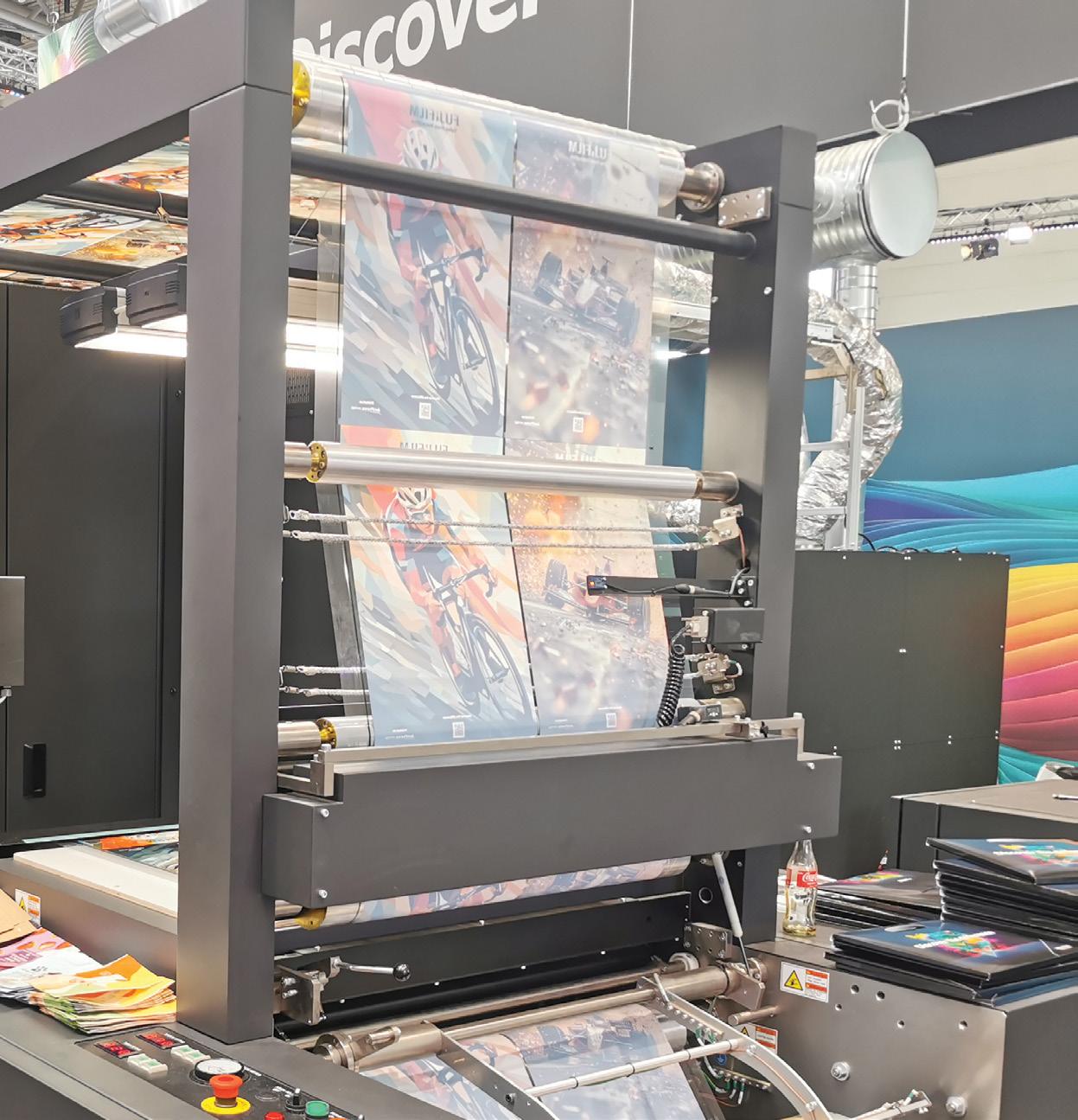
BY RALF SCHLÖZER

For some, it might be a scary prospect, while for other companies, it might be seen as an opportunity: making print more sustainable. Environmental criteria have been on the agenda for a while. Now, they are taking a central role in business decisions. Print service providers need to keep in mind a variety of stakeholders which drive the perception and requirements for print becoming more sustainable. Governments set targets and regulations in a variety of areas of environmental concern. This is driven by the majority of consumers, who desire an environmentally friendly lifestyle and economy. Businesses need to both comply with the regulations and keep customers happy. It should be stressed, however, that businesses also exist that genuinely strive for sustainable operations. In any case, companies setting sustainability targets are sending ripples, sometimes waves, down the supply chain.
Making decisions based on sustainability factors is far from easy. Consumption does have an environmental impact and often there are opposing targets to be weighed against each other. A prime example is the packaging market where different types of materials are competing. Proponents of fiber-based packaging tout paper as being a renewable resource and easy to recycle. However, certain inks, barrier materials or additives can pose problems. Supporters of flexible packaging stress the light weight of the material and shelf-life achieved,
although plastics are precarious in many other aspects. Glass and metal can easily be recycled but are energy-intensive to produce and bulky to store and transport.
The myriad of facts can confuse professionals and consumers and this is especially true for print. The German Printing Industry Association calculated the CO2 footprint of the whole printing industry to be less than 1% of all emissions. This compares to the emissions created by manufacturing and use of digital media devices, channels and networks, which accounts for about 8% of emissions created by consumers. Still, in public opinion, print is seen as a polluting industry. This is occasionally exploited by stakeholders pushing electronic media or applications. The more important it is to educate customers and the public about the environmental standing of print and, at the same time, strive for the print industry to become more environmentally conscious.
A key area to comply with regulations and to keep print buyers happy is to document and measure sustainability performance. Theoretically, everybody should be able to do this, although practical companies should enlist the help of specialists and consulting companies. Print associations, publications and environmental groups can be a good starting point at least. Outside support does not relieve company managers of dedicating resources and setting strategies to support sustainability targets.
Often sustainability is equated with curbing carbon emissions. This is certainly a major dimension, but sustainability also targets preserving the environment, avoiding the release of hazardous substances, improving recyclability or protecting consumers and operators from negative impacts of goods manufacturing and use. The cradle-tocradle concept for example focusses on several sustainability aims. We will see these factors becoming more significant in the future. The EU deforestation regulation is a case in point. There are some actions printers should take now, if not already implemented:
• Get informed on current and impending sustainability regulations.
• Prepare for a company-wide emission accounting.
• Prepare to discuss the environmental impact of print vs. alternative technologies and how product decisions impact sustainability.
• Take measures to reduce your environmental footprint.
In some cases, becoming more sustainable means higher investments or higher costs. In other cases, it might only be necessary to change processes and increase awareness of the environmental impact each process has. Reducing waste and spoilage, while increasing efficiency, not only reduces the environmental footprint, but also makes business sense. Identifying potentials and best practices will go a long way here.
Many properties of print are already established in the design and ordering of print products. Choosing the right materials, print processes, run lengths and print locations has great potential to improve sustainability. Here consulting and cooperation between the printers, print buyers, and designers is very advisable.
Environmental credentials are already a competitive advantage. In the future, they will become a business enabler and a duty for the whole company.

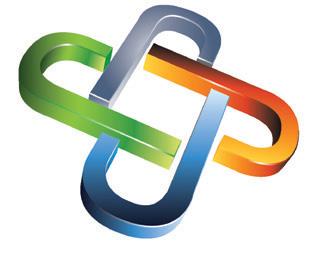
Designed by a printer wanting a single, profitable, print management solution.
Unlimited Customer Storefronts
Estimating, Shipping, Invoicing
Browser-Based
QuickBooks Integration
Barcoded Job Tickets & Tracking

BY ELIZABETH GOODING
The pressure is on companies to improve environmental sustainability practices throughout their processes and the supply chain. This impacts operating practices, materials and products used, production processes and regeneration or compensation practices. If sustainability is to be considered holistically for the print industry, we are faced with the daunting task of tracking the full range of direct and indirect contributors:
• Operational practices such as purchasing from other “sustainable” companies, operating in facilities that use solar or other renewable power sources, recycling programs, low impact transportation methods, etc.
• The level of polluting components used in materials and products as well as their ability to be reused or recycled.
• The efficiency of production processes in terms of minimum order sizes, substrate waste and energy consumption.
• Ability to offset environmental impacts through “regenerative” activities such as forest stewardship.
• Tracking the above information for key partners and suppliers.
The challenges of managing sustainability and the measures and criteria used are often oversimplified. There are tradeoffs between the environmental friendliness of materials and the energy consumption needed to process them, or the recyclability of the resulting product. Like the overarching discussion of sustainability, each component needs to be considered in holistic terms.
Consider inkjet inks, for example, where aqueous inks are “cleaner” than UV or solvent-based inks.
Aqueous inks do carry fewer volatile organic compounds, but the chemistry of water-based inks varies widely, with some containing significantly more glycols, surfactants, and biocides than others. Aqueous inks also require significant energy use
to process these additives and to purify the water. The water content also makes the inks heavier to transport and more costly to dry when printed.
Depending upon the chemistry of an aqueous ink and its intended substrate, a pretreatment may be required, which increases overall material and transportation usage and may increase energy usage necessary for drying.
While pigment inks are generally considered to be less resource-intensive than dye-based inks, the creation of pigment dispersions is an energy- and natural resourceintensive process. For a full picture of environmental impact, one must consider the comparative production process of one manufacturer and another to assess energy consumption and reliance on fossil fuels versus renewable energy sources. Also, pigment dispersions may rely on toxic substances such as carbon black. Recently, some companies such as US-based Heubach Group have begun replacing a portion of pigments with bio-based materials that can significantly reduce carbon emissions.
One must take this same, wide-perspective approach to the overall press and consider both the cost to run the press and the cost of manufacturing the press over the course of its useful life. Sustainability needs are best met when the life of a press is extended through the potential for continuous upgrade, rather than replacement and the ability to recycle or printheads and other consumables. Again, the sustainability of the OEM’s manufacturing process also contributes to the overall picture.
If sustainability is important to your buying process, be sure to ask about:
• The volume of ink needed to achieve color and print quality goals.
• The chemical composition of the ink.
• The waste and pollutants associated with the production of the ink and the opportunity to use non-toxic colorants.
• Energy needed to dry on the substrates you favor and ink coverage you require.
• Recycling and reuse programs for both parts and complete presses.
• The sustainability practices tracked and reported by suppliers that make up the solution.
As more suppliers commit to reporting on sustainability of their products and corporate practices it becomes easier to see that the sustainable choice may be very different for one type of production and another. There are many variables and tradeoffs that go into a sustainability analysis, but the work is often rewarded through uncovering economic incentives as well.

BY PAT MCGREW, WITH JONATHAN GRAHAM
You may have heard the term net zero in the context of sustainability management solutions. It has become a rallying cry for companies committed to combating climate change and aspiring to reduce greenhouse gas emissions to zero. While commendable, the path to achieving net zero is fraught with challenges, particularly in accurately gathering and reporting greenhouse gas emissions data.
Sustainability is a journey, not a destination, requiring ongoing commitment, innovation, and adaptation. Every step towards a sustainable future is a step towards preserving our planet for future generations.
There are three types of greenhouse gases (GHG), identified as Scope 1, 2 and 3. Regulation and guidance for these scopes come from The Greenhouse Gas (GHG) Protocol and the United Nations Framework Convention on Climate Change (UNFCCC). The scope framework is the most widely used international accounting tool for government and business leaders to understand, quantify and manage greenhouse gas emissions. It provides
comprehensive global standardized frameworks to measure and manage emissions from private and public sector operations, value chains, and mitigation actions.
Understanding and addressing these emissions are crucial for achieving net zero carbon emissions, which means balancing the emitted greenhouse gases with an equivalent amount of emissions removed from the atmosphere.
THE COMPLEXITY OF SCOPES 1, 2 AND 3
Scope 1 emissions are the most straightforward to measure yet still present significant challenges. These emissions are directly released from sources that a company owns or controls. Examples include emissions from company vehicles, on-site fuel combustion and manufacturing processes. For instance, a manufacturing plant emitting CO2 from its boilers falls under Scope 1. Monitoring and reducing these emissions require direct intervention, such as upgrading equipment or switching to cleaner energy sources.
Scope 2 emissions stem from the consumption of purchased electricity, steam, heating and cooling. These emissions occur at the utility provider's facilities, but the consuming company is responsible for them. A building using electricity from a coal-fired power plant must account for these emissions. Companies can mitigate Scope 2 emissions by purchasing renewable energy or improving energy efficiency.

Scope 3 emissions encompass vast and complicated indirect emissions throughout the value chain. Given their breadth and complexity, these emissions are notoriously difficult to measure and manage.
There are 15 distinct categories under Scope 3, each presenting unique challenges:
1. Purchased Goods and Services: Emissions from producing goods and services that a company buys.
2. Capital Goods: Emissions from producing longterm assets such as buildings and machinery.
3. Fuel- and Energy-Related Activities: Emissions related to the extraction, production, and transportation of fuels and energy purchased by the company.
4. Upstream Transportation and Distribution: Emissions from transportation and distribution of products purchased by the company.
5. Waste Generated in Operations: Emissions from the disposal and treatment of waste generated by company operations.
6. Business Travel: Emissions from employees' business travel.
7. Employee Commuting: Emissions from employees commuting to and from work.
8. Upstream Leased Assets: Emissions from leased assets not included in Scope 1 and 2.
9. Downstream Transportation and Distribution: Emissions from transportation and distribution of sold products.
10. Processing of Sold Products: Emissions from the company's processing products.
11. Use of Sold Products: Emissions from consumer and business use of sold products.
12. End-of-Life Treatment of Sold Products: Emissions from the disposal of products sold by the company.
13. Downstream Leased Assets: Emissions from the company's leased assets.
14. Franchises: Emissions from franchise operations.
15. Investments: Emissions from investments, such as equity and debt investments.
While Scopes 1 and 2 are challenging, Scope 3 emissions take the complexity to another level. Tracking emissions across a value chain that includes suppliers, transportation networks, and end-users requires immense effort and sophisticated tracking systems. Companies must rely on data from multiple external sources, often leading to inaccuracies and inconsistencies.
Reducing Scope 3 emissions to zero is tricky; it borders on the impossible for many businesses. It demands unprecedented coordination and cooperation across the entire supply chain, from raw material extraction to product disposal. Additionally, the cost and effort required to collect accurate data can be prohibitively high, especially for small and medium-sized enterprises.
When discussing net zero, it's essential to address the challenges of carbon credits or offsets, a common strategy that companies strive for net zero. Carbon credits allow companies to invest in projects that theoretically mitigate emissions elsewhere, such as reforestation or renewable energy initiatives. However, carbon credits come with inherent risks and limitations. They often lack transparency and can be subject to controversy regarding their effectiveness in truly offsetting emissions.
Carbon credits' reliance on vague and inconclusive predictions is a significant issue. For example,
credits based on future emission reductions, like planting saplings expected to sequester CO2 over decades, do not effectively address current emissions. The accepted practice is that compensation should occur with carbon credits sold after the carbon removal or emission avoidance.
Recent news from companies like Nestlé underscores a growing trend among businesses moving away from carbon offsets in favor of more direct emissions reductions. This shift highlights the need for more robust and credible strategies to reduce emissions at the source.
As companies grapple with the complexities of achieving net zero emissions, focusing on activities that can bring real change and contribute to a more sustainable future is crucial. A critical activity is building robust sustainability management systems (SMS). An SMS provides guidelines for a facility to evaluate, manage and improve sustainability by tracking and optimizing resource usage.
An SMS offers a structured framework for measuring, managing and enhancing environmental performance across all emissions scopes. By implementing an SMS, companies can drive continuous improvement, enhance transparency, and build trust with stakeholders. The Sustainable Green Printing Partnership (SGP) offers a publicly vetted SMS template, providing companies with a valuable resource to develop their sustainability strategies. Investing in an SMS allows companies to lay the foundation for sustainable growth and resilience in an increasingly carbon-constrained world.
Navigating the path to net zero emissions is undeniably challenging. Creating and continually improving a Sustainability Management System (SMS) for your company is a more manageable and practical approach. By acknowledging the limitations of carbon offsets and embracing robust sustainability management systems, companies can chart a course toward genuine environmental stewardship and long-term success. Sustainability is a journey, not a destination, requiring ongoing commitment, innovation and adaptation. Every step towards a sustainable future is a step towards preserving our planet for future generations. Let's make it count with real improvement and impact that can be easily tracked and reported via a Sustainability Management System rather than relying solely on a net zero commitment.

Many global brands have been actively defining their sustainability strategies. Nestlé has been vocal in their sustainability journey, noting in their Planet Tracker, "Our Net Zero Roadmap does not rely on offsets. We focus first on reducing emissions as far as possible. The remaining emissions are then addressed through in-setting: using natural climate solutions to increase the storage of carbon in the land and soils in our own value chain." Nestlé achieved a net reduction of 13.5% of its greenhouse gas (GHG) emissions in 2023 compared to its 2018 baseline, while continuing to grow its business over the same period. This included delivering a reduction of more than 15.3% in methane emissions. The company has successfully decoupled its growth from its emissions and is on track to reach a 20% absolute reduction of GHG emissions by 2025. The report is available at www.nestle.com/asknestle/environment/answers.
You can find similar trackers and statements on the websites of many companies. Even the US Securities and Exchange Commission (SEC) adopted rules in March, 2024, to standardize sustainability and other climate-related disclosures by public companies and in public offerings. SEC Chair Gary Gensler says, “The rules will provide investors with consistent, comparable, and decision-useful information, and issuers with clear reporting requirements. Further, they will provide specificity on what companies must disclose, which will produce more useful information than what investors see today. They will also require that climate risk disclosures be included in a company’s SEC filings, such as annual reports and registration statements rather than on company websites, which will help make them more reliable.”
BY RICHARD ROMANO
drupa has never been a big show for display graphics and signage, and while there were companies showing their wide-format printers, major announcements are usually reserved for the ISA Sign Expo, FESPA and/or PRINTING United. But there were still some interesting, unique and even potentially game-changing items on display. Let’s take a look back at some display graphics technology announcements—and look ahead to PRINTING United.
There was one unique display graphics system at drupa that I’ll be following up on, and that was a “direct-to-wall system” by a German company called wallPen. The company had its beginnings 25 years ago, according to the company’s website, when Andreas Schmidt was working in the field of training, presentation and sales of 3D CAM/CAM software. Intrigued by the idea of printing on walls after seeing some Chinese wall printing equipment on Alibaba, he ordered some, intending to sell them in Europe via his own company. However, as the website says, “The Chinese printer finally arrives, but bursts into flames on the very first attempt to print.” Well. He tries with some more expensive printers, but is dissatisfied with the quality, so decides to build a unit himself. In 2016, the wallPen Evolution 1 (E1) is finally ready and has a successful start. And wallPen is off to the races.
The full story will merit a longer standalone story but suffice to say here the wallPen E2 is the current model, which was what was being shown at drupa. The system comprises a set of rails that are laid on the floor and a movable axis system that controls height, printheads, and electronics, designed for easy assembly and disassembly. The device uses fourcolor (CMYK) LED UV inks, with an option for a fifth color such as white. It uses Ricoh Gen 5 printheads that print at a maximum resolution of 1,200 dpi at speeds that vary from 2 to 16 sq. m/hr.

Image courtesy wallPen.
It can print at a height of up to 4m with virtually unlimited width. The company says that all kinds of surfaces can be printed on, with a primer required only for very smooth, “difficult” surfaces such as glass. The E2 costs around €50,000, is sold directly by wallPen in Germany and through sales partners in other countries.

I’ve seen various incarnations of direct-to-wall printers; EFI Connect used to be held in Las Vegas at the same time as The World of Concrete Show and one Connect attendee had checked out the concrete show and mentioned a wall (concrete wall, natch) printer on display, which sounded intriguing, although it never turned up on my radar elsewhere. And two years ago I wrote about a prototype robotic inkjet printing system developed at the Southwest Research Institute (SwRI) designed to print directly onto three-dimensional surfaces—specifically, airplanes. And back at PRINTING United 2019 Ricoh was showing a video of a system developed in Japan that printed (actually painted) graphics on the sides of trucks, for example, although I never heard anything more about it. (Hmm…what could have happened in 2020 to take my mind off it?)
These kinds of vertical printers are very cool and also solve the problem of having to print then mount images (the same kind of solution that flatbed printers offered), but have their limitations. Specifically, the printer has to be physically taken and installed at the customer site, which is not without logistical problems and also contrary to the way shops like to print things. Also, one benefit of print-and-mount wall printing solutions is that the images can (more or less) be easily removed. I don’t know about the permanence of wall printer ink, but if it’s a very temporary display, it may not be a desired solution. I can see this kind of system being used by sign companies, as they are accustomed to intricate installation projects.
Still, this is a display graphics technology I look forward to following up on.
As Cary Sherburne and I have been writing and talking about for the past few years (together and separately), display graphics and textile printing have been growing more closely entwined. Sewn together, you might say.
Several manufacturers have been helping bridge that gap. Mimaki is one, with full sets of both display graphics and textile printers.
For display graphics producers, Mimaki offers solvent, eco-solvent, latex and UV flatbed devices, and at this year’s drupa was focusing on the latter, highlighting how its UV print technologies can help users reduce energy consumption, minimize volatile organic compound (VOC) emissions and generate less waste.
Mimaki has also offered a range of direct-to-object printers, including the UJF-6042 MkII e, capable of 360° printing on cylindrical objects like water bottles with the Kebab HS unit. Meanwhile, to boost automation options, two industrial-grade UJF7151 plusII UV printers will feature robotic arms for automated board on- and off-loading.
Mimaki has long used trade events to provide an “applications showcase” that demonstrates the breadth of the applications that can be produced on Mimaki’s equipment, and drupa 24 was no exception. Their showcase included printing on fabrics, garments, merchandise, household ware, packaging, utility products and more.
Besides showing a textile printer for the rapidly developing direct-to-film market, Mimaki was also presenting some other recent developments in textile print. The Trapis technology is a new waterless transfer process using a special pigment ink and dedicated transfer paper—it is, in a nutshell, “dyesub for non-polyester textiles” and supports cotton,

BY PAT MCGREW
Bringing a stand to drupa is a big task. It is easy to focus on the products, but differentiation calls for creative thinking. Danna Drion, General Manager Marketing & PM EMEA at Mimaki Europe B.V. is one of those creative thinkers. In building the Mimaki stand, she went to users of the Mimaki solutions to find exhilarating examples of how artists use the versatility of Mimaki solutions to create décor art, wearable art and 3D art.
One of the contributors is visual artist Kinda Youssef was born in Syria in 1984. Today she leverages artificial intelligence tools to weave together memory and imagination, creating compelling images you saw as you entered the Mimaki stand. The art installation was called Weaving Memories—Bringing Realities.
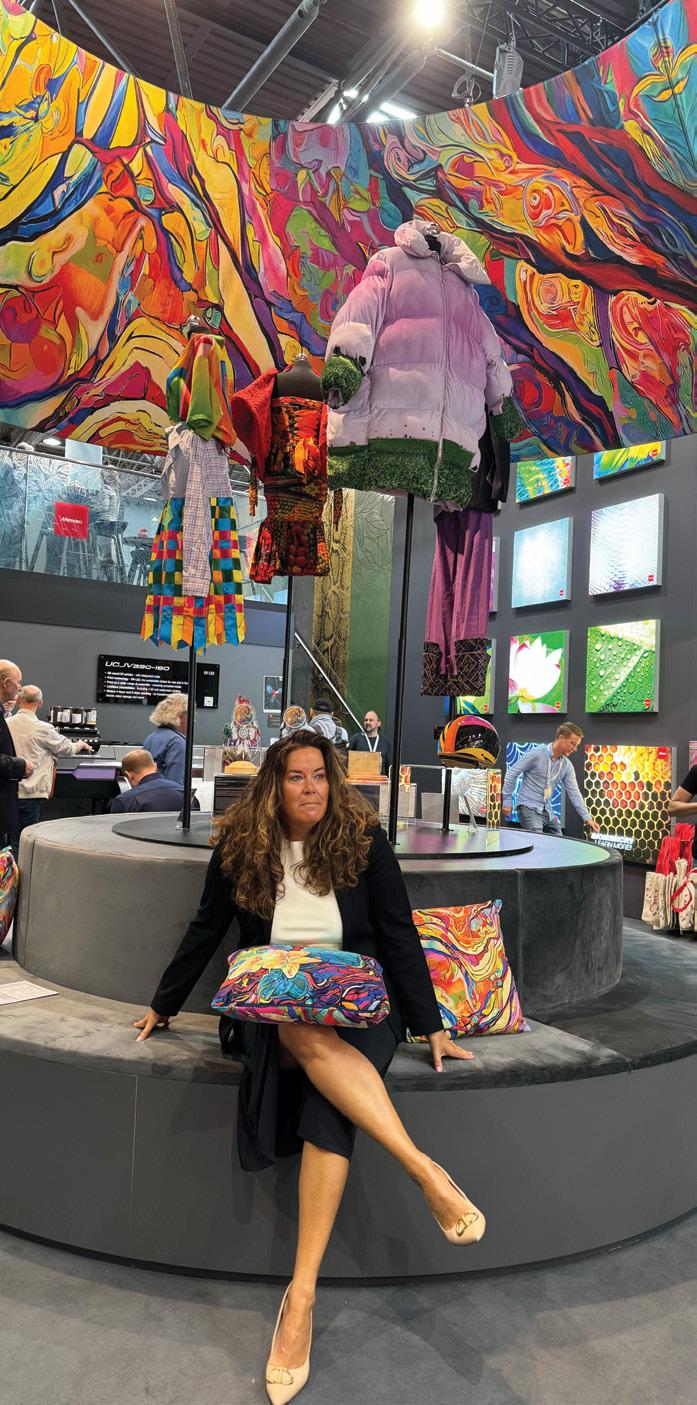

She begins by drawing on her memories and desires/ longings, translating them into prompts for AI image generation tools. These AI-generated images then act as a springboard for a collage-like process. Youssef meticulously paints within the computergenerated landscapes, constantly refining them to evoke the most vivid recollections from her mind. Through this interplay between memory, technology and artistic intervention, Youssef's creations bridge the gap between the real and the imagined. Once you see the creations, you’ll want to know more. Her portfolio is at instagram.com/ kindaimages.
Another featured artist at drupa was Lilach Porges who created
Dress Code. Using the Mimaki TX300P-1800 MkII and Rc400 reactive ink, this collection focused on the merger between technology and fashion. It combined looks 3D-printed by a robotic arm using sustainable materials to explore the aesthetics of this technology. The exhibit compared traditional methods, such as pattern making and fabric sewing, to 3D printing by hand and by a robot, where software becomes art and is translated into wearable objects. For more info on their designs, see procode-dress.com and instagram.com/lilachporges. There were many other amazing clothing creations in the stand that used the Mimaki technologies.
Watch our video interview with Danna Drion
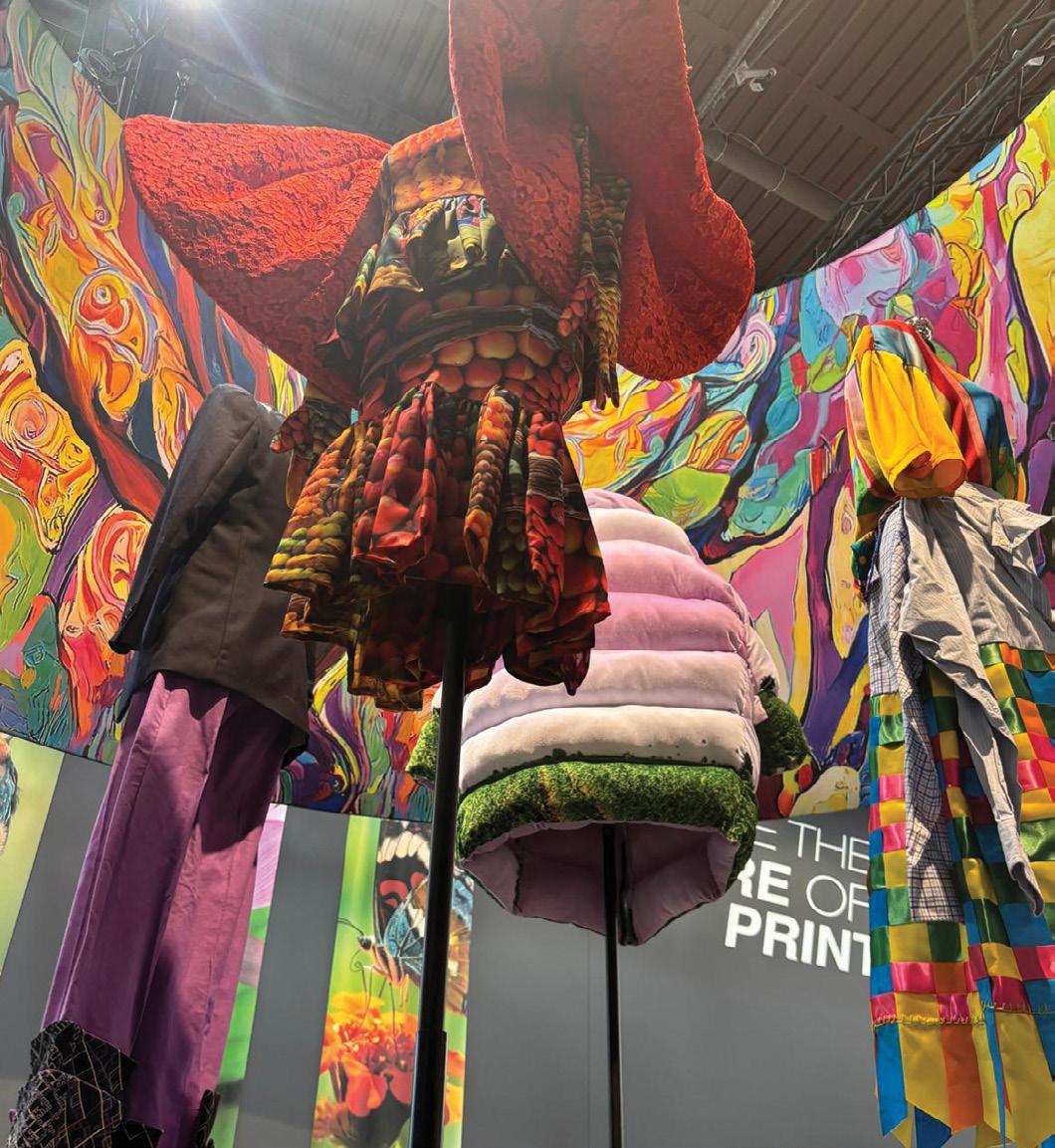
linen, silk and blended fabrics with one ink type. It is a two-step process of printing and calendering the print onto the textile. To further improve the environmental footprint of textile production, Mimaki also recently introduced its Neo-Chromato process, which allows deinking of previously dyed polyester textiles for future reuse.
EFI has been another pioneer in merging display and textile printing. Earlier this year at FESPA, EFI launched two new display graphics printers: the 3.3m VUTEk Q3h XP hybrid flatbed/roll-fed LED printer and the 3.2m EFI Pro 33r roll-to-roll LED printer.

The EFI Reggiani line of printers has also continued to help the company become pioneers in the realm of digital textile production. Indeed, WhatTheyThink had partnered with EFI to use EFI Reggiani digitally printed textiles to serve as a backdrop for the WhatTheyThink video studio onsite at drupa 2024. EFI also produced a range of scarves that could be worn by video interviewers as well as a stunning “drupa red” backdrop for the studio.
“I’m excited to be able to wear these stunning scarves on camera,” said Cary Sherburne, Senior Editor at WhatTheyThink and primary video interviewer during the first half of the show. “I had the opportunity recently to view a number of potential designs at EFI’s new facility in Bergamo, Italy, and see some of these pieces being produced on a variety of printers, ranging from the EFI Reggiani COLORS with its stunning color results, to EFI

Reggiani BOLT XS at the high end, as well as the EFI Reggiani ecoTERRA, which will be featured at drupa. The colors are brilliant, and the pieces have a very soft hand feel. Our hope is that having these fabric pieces in our studio and featured on our videos will inspire the textile industry to move faster to adopt digital fabric printing technologies such as those being offered by EFI Reggiani. Digital textile printing is more sustainable and can be more cost effective when considering the ability to move product to the market faster while reducing inventory risk. And long gone are the days when brands, retailers and consumers have any issues at all with the quality that can be achieved.”
Another pioneer in the digital textile printing space has been Kornit Digital, with direct-to-garment and direct-to-fabric systems designed to help print service providers, textile designers, and apparel producers take advantage of opportunities in the growing market for on-demand, digitally printed apparel and décor.
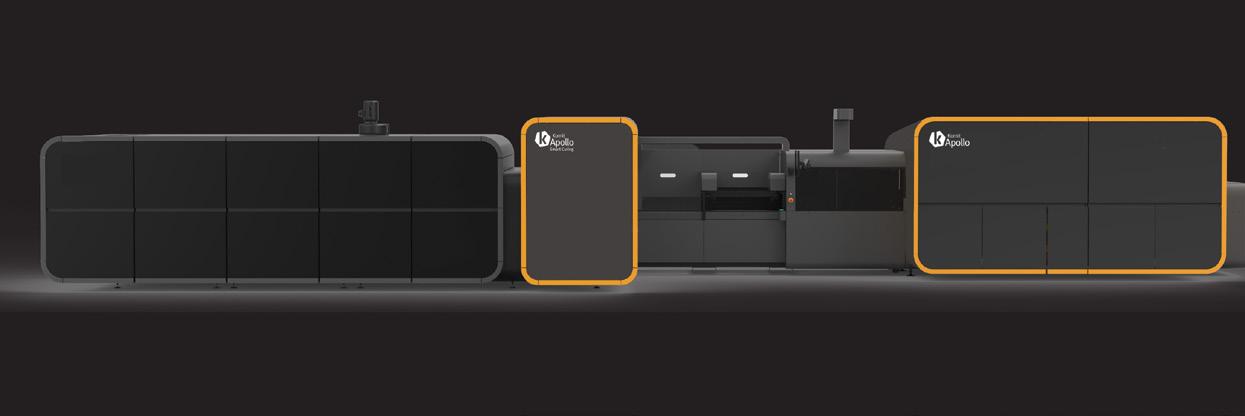
The company’s flagship is Apollo, a high-speed, a highly automated inkjet press designed for shortrun production that can be impractical on analog screen equipment. Based on patented Kornit MAX technology, the Apollo uses pigment ink that is compatible with a wide range of fabrics, including cotton, polyester, cotton-polyester blends, Lycra, rayon, silk, leather, denim, linen and wool. Output speed is cited at 400 shirts per hour in an automated workflow tended to by a single operator. The production process includes garment scanning, semi-automatic loading, automatic unloading and smart curing.
Kornit also offers the Atlas MAX POLY with integrated Kornit Orion Smart Dryer, a system for producing professional and recreational sportswear/teamwear— as well as licensed gear— and is a highly efficient system for polyester decoration, supporting blends, tri-blends and other synthetic fabric combinations. It produces vibrant output via neon inks.

For what the company calls “pixel-to-parcel garment delivery,” the KornitX Global Fulfillment Network optimizes operational efficiency, eliminates supply chain bottlenecks, and ensures that products are readily available. Basically, it connects brands, retailers, and digital platforms to a high-quality production network—providing real-time inventory resupply and trend adaptability for direct-togarment production.
Another print niche that is also becoming more adjacent to display graphics is direct-to-object printing which, since the advent of UV flatbed devices, has been a subset of “wide format.” It is also nearing the label/packaging space, as direct-toshape or direct-to-object printing is also increasingly being seen as an alternative to label printing. It’s the old “avoid print and mount” trope: why not print directly on a 3D object?
Roland has long offered direct-to-object printing with their line of “benchtop” UV printers that could print on 3D objects. They have doubled down on direct-to-object printing with the recently launched VersaObject line of UV printers. In June, they announced the North American availability of the
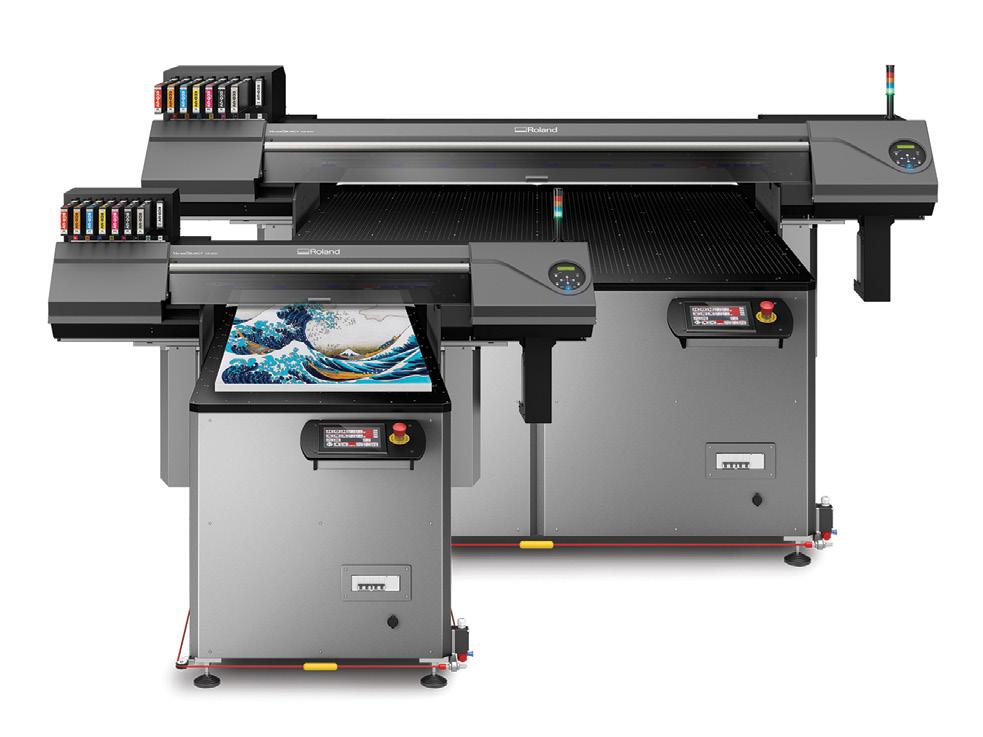
most recent units in this line, the VersaObject CO-i Series—two UV-LED flatbed inkjet printers capable of printing directly onto substrates and objects up to 9.5 in. in height and weighing up to 640 pounds— though you’ll have to hire a professional weightlifter if you want to take full advantage of the weight capacity. The series comprises the 30-in. CO-300i-F2 and the 64-in. CO-640i-F3 and both units let users print vibrant, detailed graphics and text onto a wide range of materials and 3D items, including objects with curved or uneven surfaces. And they are compatible with a wide range of potential substrates, including plastic, wood, canvas, vinyl—and, hey, even paper, which seems like it’s becoming an exotic substrate these days! They also include a Primer ink for adhesion optimization on difficult surfaces such as glass and metal.

Another direct-to-shape solution that was being demonstrated at drupa was LabelSaver, as its name indicates, designed to preclude the need for label printing. LabelSaver is a joint venture of three companies: ideeGO, which developed the mechanics and inkjet integration, O&PM (Offset & Print Management),which contributed the chemistry, and KFlow, which supplied the front end. Substrate/ object transport is handled via a programmable robotic arm that picks up containers or other objects and guides them under the printhead assembly. It can also print on cylindrical objects. Unlike other directto-object printers that use UV inks, LabelSaver uses aqueous inks, thanks to a primer developed by O&PM that optimizes adhesion on those difficult materials like plastic and metal. Speeds can range from 200 to 1,000 containers per hour.
The LabelSaver that was demonstrated at drupa was configured with near-infrared drying units and printheads from Seiko Instruments. Heads from other inkjet suppliers can be used as well.
One display graphics technology I’m keeping my eye on is single-pass. EFI’s Nozomi platform, originally developed for corrugated, now has a unit designed for sign and display graphics: the Nozomi 18000+, a 1.8m/71-in. wide printer with a production speed of 3,000 to 5,000 sq.m/hr.
Fujifilm partnered with Barberán to develop the Fujifilm HS Series, a single-pass inkjet technology that combined Barberán’s precision engineering and Fujifilm’s inkjet technology, to offer print speeds of over 6,000 sq.m/hr. A key feature of the series is its modularity, each press being tailor-made for specific business needs.
The buildout of single-pass units is another display graphics technology to keep one’s eye on.
3D printing is one of those technologies that seem really cool but our regular industry surveys show very little interest in it. Still, some firms, not necessarily print service providers, have carved out a niche using 3D printing for things like custom-printed game pieces for the gaming market, marketing and promotional displays and even far afield printing in the production of props for movies, TV shows and stage plays. (I once investigated the potential use of 3D printing in signage for producing, say, channel letters but the consensus was that the materials used to build up the shapes lacked sufficient resistance to UV and other external elements—plus it was a more expensive process than traditional manufacturing. Still, I had to ask.)
One big player (in several senses of the term) in 3D printing has been Massivit, provider of high-end 3D printing systems, and at drupa they launched the new Massivit 3000, a more affordable entrylevel-ish 3D-printing solution for businesses seeking to economically add high-speed production capabilities. Targeted toward print service providers, event fabricators and prop makers, the device is designed to produce giant, captivating displays for marketing, retail and advertising campaigns. The new printer also enables ultra high-speed production of 3D window displays, dimensional billboards, custom channel letters (but see above), combined 2D/3D point-of-purchase displays, interactive event props, theme park scenery, and molds for thermoforming. It has a print volume of ~1.2 x 1.5 x 1.8m (4 x 5 x 6 ft.). It is based on the same Gel Dispensing Printing (GDP) technology that has been utilized by Massivit’s past and present 3D printing systems.
Late last year, Kongsberg Precision Cutting Systems announced the Kongsberg Ultimate, which made its public debut at drupa. Kongsberg Ultimate is a new digital cutting platform that features an innovative drive technology that can achieve an acceleration rate of up to 2.74 G and a cutting speed of 168 m/min. Not just for display graphics, the new platform was also optimized for corrugated cutting applications.
At drupa, the company also offered a sneak preview of the future of automation, at least on Kongsberg systems—a new seven-axis robot cell that allows customers to increase throughput utilizing multiple pallets and multiple cutting systems.
I wrote about the latest developments in cutting tables right after the ISA Sign Expo, but suffice to say the biggest development is robotics. Zünd was one of the first cutting table manufacturers to offer robotic for loading and unloading, and at the Sign Expo, Zünd was demonstrating a Robot PortaTable, a mobile off-load table equipped with a robotic arm. The Visualizing Option, with optical part marking and the use of printed QR codes, offers more ways to facilitate the production process and make it more efficient. The use of metadata enables end-to-end job tracking and guarantees smooth and efficient logistics throughout the production process.
Complementing its wide array of printers, both rollfed and flatbed, Mimaki launched (in North America) its CFX Series of production flatbed cutters at the International Sign Association (ISA) Sign Expo in April. (The line had debuted a few weeks previously in Europe at the FESPA Global Print Expo.) The CFX Series cutters are intended to be paired with Mimaki’s JFX Series of UV flatbeds. It will be interesting to see if any other display graphics printer manufacturers also offer complementary finishing systems.
So there’s a lot of “stuff” going on—and that’s just what we had space for! A lot of it looked back at drupa—which emphasized many vendors’ European businesses and launches, but as PRINTING United comes into focus, we’ll start seeing more North America-specific announcements.
If any of the technologies/products I mentioned above look like they’re up your alley, and you’ll be at the show in Vegas next month, be sure to check out the PRINTING United Exhibitor List to see if they’ll be exhibiting. And, if so, I’ll see you there!
Patrick Henry, Ryan McAbee, Pat McGrew, and Ralf Schlözer contributed to this article.
BY JOANNE GORE
From digital manufacturing to automated workflows to robots on the shop floor, the last decade has witnessed a seismic shift in the print industry. The introduction of Al solutions like ChatGPT, Perplexity, Claude, and Dall-E, have captured the attention of millions of users- 16 million users alone were prompted to create their first-ever Linkedin™ post1 thanks to Al. As a result, these technological revolutions have left many print service providers (PSPs) at a crossroads: adapt and thrive or resist and risk obsolescence. This article explores the 10 technologies that have reshaped the industry, their impact, adoption patterns, challenges faced by printers, and practical tips to overcome the fear of new tech.
10 TECHNOLOGIES
1. Digital Printing Presses: Digital printing technology, introduced in the early 1990s, has dramatically evolved from basic color printing to high-speed, high-quality presses. Today's digital presses can handle a wide variety of media types and offer unprecedented print quality and speed, making short runs and on-demand printing economically feasible. This evolution has blown up new markets and opportunities for personalized and variable-data printing.
2. Artificial Intelligence (Al): Al in the print industry has exploded over the past decade, initially focusing on basic automation and evolving into predictive analytics and advanced customer personalization. Al now helps optimize print layouts, reduce waste, estimate jobs and enhance marketing campaigns. Its adoption continues to reshape operational efficiencies and customer engagement practices. Infigo estimates2 that an employee can manually check up to 10,000 files per month, whereas an Al tool can process the same number of files in two to four minutes.
3. Augmented Reality (AR) and Interactive Print: Since the late 2000s, AR has enhanced print materials with
virtual experiences-bridging the gap between physical and digital realms. When Lionsgate integrated QR codes into their movie marketing and promotional strategy, they amassed ever 12,000 engagements across 65 different cities3. Transformed from a novel concept to a practical marketing tool, embedding digital content like videos and 3D models into physical print, creates memorable "phygital" immersive experiences that increase user engagement and information retention.
4. 3D Printing: Introduced in the 1980s, 3D printing has moved beyond prototyping to become a tool for direct manufacturing in the print industry. Recent advancements allow for the printing of complex shapes and materials, including metals and biodegradable substances. Today, 3D printing can produce everything from promotional items to custom machine parts— within hours. This is especially helpful if you're in a remote location waiting on a part for your downed press.
5. Sustainable and Eco-Friendly Materials: The demand for sustainable printing solutions has surged in the last decade, driven by environmental concerns and consumer preferences. On a mission to print responsibly and pave the way for a greener, more sustainable future, the industry is adapting - with more eco-friendly inks, recycling and waste reduction programs, de- inking technologies and energy-efficient processes to reduce their ecological footprint. Digital press manufacturer Xeikon is one OEM that has introduced new toners with 60% recyclable materials, reducing their print technology's carbon footprint by over 10%.
6. Cloud Computing: Cloud computing's role in the print industry has ballooned over the past 15 years. Initially used for data storage, it now facilitates collaboration, remote working and integrated workflows across global teams. Cloud platforms enable PSPs to access and process large files quickly and securely, enhancing productivity and operational flexibility.
7. Data Analytics and Big Data: In the early 2000s, data analytics in printing was limited to basic customer demographics and order history. Today, it encompasses comprehensive analysis of consumer behavior, predictive modeling and personalized marketing strategies. Big data tools allow PSPs to optimize their operations, tailor marketing efforts and improve customer experiences based on real-time insights.
8. Web-to-Print/Web-to-Pack Solutions: Web-toprint technology, emerging in the early 2000s, has revolutionized customer interaction by allowing customers to customize and order print online. Over the years, the technology has evolved to support complex
1 https://richardvanderblom.gumroad.com/l/Algorithm-Insights-2024
2 https://2652388.fs1.hubspotusercontent-na1.net/hubfs/2652388/infigo-aiin-print-white-paper.pdf
3 https://www.uniqode.com/blog/qr-code-insights/ qr-code-trends-report/
workflows, real-time proofing and seamless integration with PSPs' production and payment systems. Fueled by the "Amazon Experience" W2P empowers customers with DIY design tools, streamlines the ordering process, enhances efficiency and improves satisfaction— as well as the likelihood of repeat business. Oberlo4 reports that as of 2024, there are 270.11 million online shoppers in the US, marking an 8.1% increase from the previous year. The number of online shoppers is expected to rise annually, reaching 331.46 million by 2029. Businesswires5 valued the Web-to- Print Services market at US$29.58 billion in 2021 and projects it to reach US$39.99 billion by 2027.
9. RFID and Smart Packaging: RFID technology has been used in various industries since the 1980s, but its application in print, particularly in smart packaging, has grown substantially in the last decade. Embedded in packaging, RFID tags make it easy to track shipments, manage inventory, reduce theft and fraud and increase operational efficiencies. Plus, by enhancing supply chain transparency, the technology offers new ways for brands to engage with consumers. Fortune Business Insights projects the global smart packaging market size to increase from $24.66 billion in 2024 to $40.32 billion by 2032.
10. Workflow Automation and Software: Workflow automation in the print industry began with simple prepress tasks and has evolved into comprehensive systems that manage entire production lines. Modern automation software integrates with digital and/or offset presses, finishing equipment and customer management systems to reduce manual, repetitive, error- prone tasks and costly errors. This evolution has significantly improved turnaround times, operational efficiency, and overall productivity.
The introduction of these technologies has led to significant improvements in efficiency, quality and customer engagement. Digital printing presses and Al have reduced turnaround times and enhanced customization options, meeting the rising expectations of modern consumers. AR and interactive print have created new marketing opportunities, turning print materials into immersive experiences. The push towards sustainability has not only aligned with consumer preferences but opened up new markets and revenue streams.
While large enterprises have been quick to adopt these technologies, small and medium-sized PSPs are increasingly recognizing the need to innovate. Niche markets, especially in custom and specialty printing, are leading in the adoption of 3D printing and sustainable materials.
However, barriers remain, particularly for smaller players, due to cost and complexity concerns. Many business owners hesitate to adopt new technologies due to the high initial costs, the complexity of integration and a lack of skilled personnel to manage these advanced systems. The fear of disrupting existing workflows and uncertainty about the return on investment play a significant role in this resistance.
1. Start Small: Begin with less complex technologies and gradually scale up as comfort and confidence grow.
2. Educate and Train: Invest in ongoing training programs to upskill staff and ensure they are equipped to handle new technologies.
3. Collaborate: Partner with technology providers for expert support and to leverage their experience in successful implementations.
4. Focus on ROI: Conduct thorough cost-benefit analyses to understand the long-term financial advantages of new technologies.
5. Pilot Programs: Test new technologies in limited, controlled projects to evaluate their impact before full-scale implementation.
6. Stay Informed: Keep abreast of industry trends and technological advancements to make informed decisions.
7. Feedback Loop: Encourage feedback from staff and customers to refine and optimize the use of new technologies.
8. Network: Engage with industry peers at events and forums to learn from their experiences and share best practices.
9. Customer-Centric Approach: Ensure that technological upgrades enhance the customer experience and meet their evolving needs.
10. Future-Proofing: Select scalable and adaptable solutions to accommodate future growth and changes in the industry.
4 https://www.oberlo.com/statistics/how-many-people-shoponline-in-the-us
5 https://www.businesswire.com/news/home/20220616005505/en/GlobalWeb-to-Print-Market-Report-2022-to-2027---Featuring-Agfa-GevaertAleyant-Systems-and-EPS-Among-Others---ResearchAndMarkets.com
The future of the print industry is inextricably linked to technological innovation. By embracing these changes and adopting a proactive, open-minded approach, PSPs can secure their place in a rapidly evolving marketplace. The journey may be challenging, but the rewards of increased efficiency, customer satisfaction, and business growth are well worth the effort.
BY PETE BASILIERE
In the ever-evolving print technology landscape, hardware, software and material advances place printed electronics at the intersection of groundbreaking lithographic, gravure, screen, flexo and inkjet printing technologies. As the demand for flexible, stretchable, lightweight, wearable and cost-effective electronic devices soars, so do your opportunities in printed electronics.
How do you leverage your business to take advantage of the market? Let's consider the print hardware technologies driving the growth of printed electronics and the market trends in this dynamic industry.
Printed electronics are electronic components and devices produced with printing technologies. The electronic devices are typically integrated circuits, sensors and other elements incorporated into a wide range of products. Produced on various substrates, printed electronics may be fully functional conductors, semiconductors, resistors, dielectrics and optical materials.
As the technology providers listed below demonstrate, printed electronics leverage innovative techniques and materials to produce electronic components. These technologies include 2D printing (inkjet, screen, flexography, gravure) and 3D printing (additive deposition by jetting or extrusion). Each method offers unique advantages, from prototyping and short-run production to high-volume production capabilities.
As you know, inkjet printing produces intricate and precise designs on a range of substrates with a variety of inks, making it ideal for finely detailed applications and unique functions. On the other hand, screen and flexo printing stand out as mass manufacturing methods, enabling the cost-effective deposition of various functional materials on diverse substrates.
3D printing presently has limitations but produces unique printed electronics in assorted shapes and thicknesses.
Moreover, material science innovations contribute to the expansion of printed electronics. Conductive inks, for example, empower designers and engineers to create innovative products ranging from flexible displays and wearable sensors to smart packaging and RFID tags. Furthermore, advancements in printable substrates have nurtured the development of flexible, lightweight and even stretchable electronic devices.
According to IDTechEx, the global market for printed electronics is forecast to reach $12 billion by 2033, a 10.0% CAGR that far exceeds the market for print on paper.1 The growth is driven by the escalating demand for lightweight, portable, wearable and energy-efficient devices across diverse industries. With applications spanning packaging, consumer electronics, healthcare, automotive and aerospace sectors, printed electronics remakes how we interact with technology as consumers and businesspeople. For example, IDTechEx found that “Electrification demands a rethinking of almost every component within (electric vehicles). There is a market pull for technologies that reduce weight and power consumption to extend battery range while offering complementary premium features to the passenger... Despite some industry disillusionment, a killer application with the potential to tip the scales toward printed technology is emerging: battery management.”2
Flexible displays also drive market growth, with printed electronics offering seamless integration into curved surfaces and, importantly, unconventional form factors. Additionally, printed electronics fuel the adoption of multifunctional printed sensors and antennas (RFID and NFC3), enabling pervasive connectivity and data collection. A straightforward example is that, rather than carrying a fat key fob in my pocket, I use my smartphone (that goes wherever I go) and its NFC antenna to open the door to my 2022 BMW. Printed electronics offer innovative and versatile solutions to diverse industries. Staying ahead of the curve is paramount to your success in the rapidly evolving landscape. By having participated in drupa or
1 Flexible & Printed Electronics 2023-2033: Forecasts, Technologies, Markets," IDTechEx; the forecast excludes the market for OLEDs
2 Printed Electronics Converge: 3 Key Insights from LOPEC 2024," Dr. Jack Howley, March 20, 2024
3 RFID: radio frequency identification; NFC: near-field communication
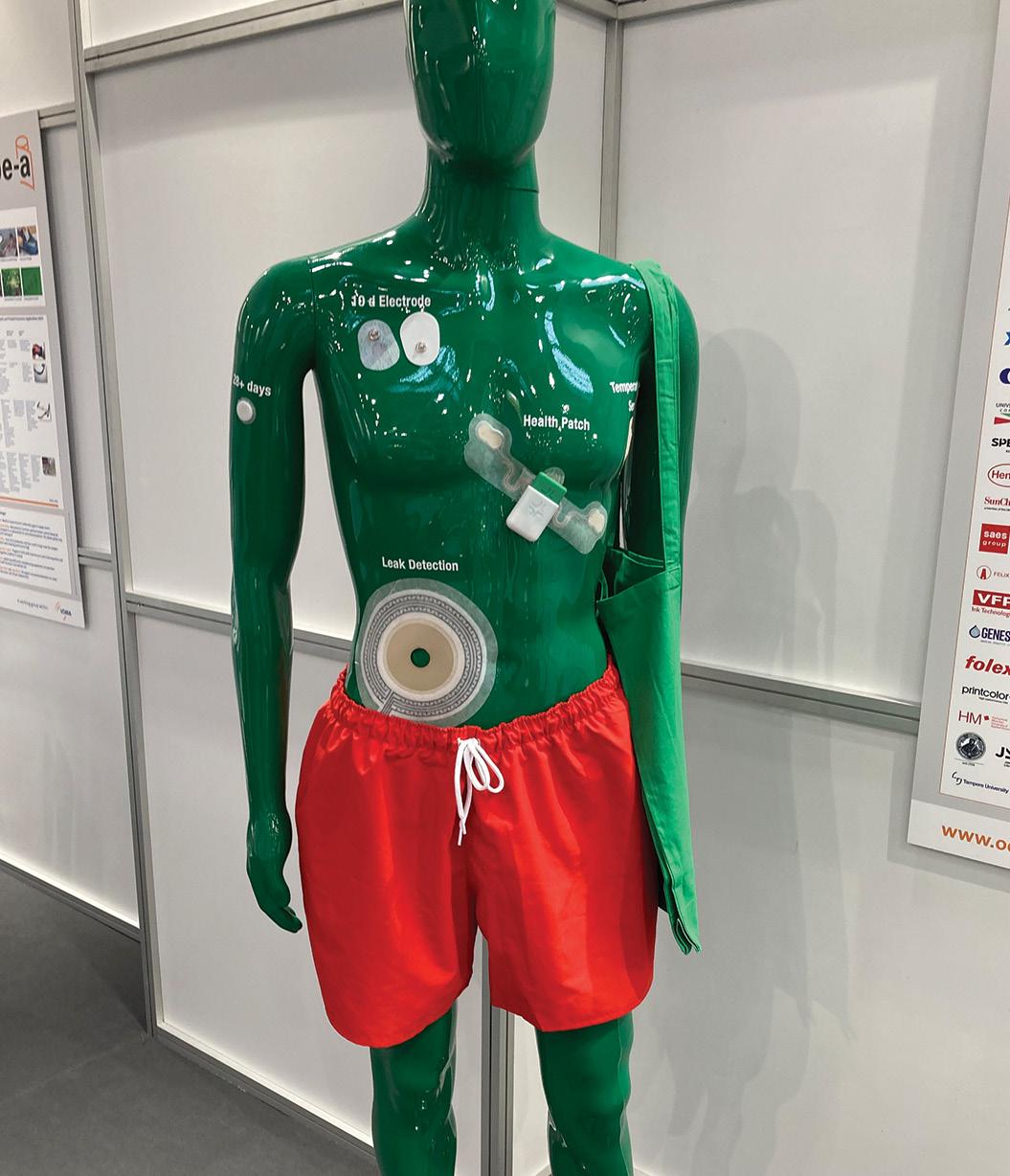
absorbing WhatTheyThink’s show coverage, printed electronics producers had the potential to gain unparalleled exposure to market trends, innovative solutions and business opportunities.
While “drupa” is a portmanteau of the German words for print and paper (druck und papier), the exhibition of global technology providers is much more than 2D printing. For producers of printed electronics, the event in Düsseldorf represented a premier platform to see the latest innovations, initiate or strengthen vendor partnerships, and stay abreast of global industry developments.
I attended four drupa events since the early 1990s and found them all to be extensive (and exhausting!) exhibitions with the latest advancements in printing machinery, materials, and applications—and where the smallest booths shine the brightest lights on where print technology is going. From a printed electronics perspective, several exhibitors stood out:
• adphos manufactures, services, and supports a wide range of standard and custom solutions for printed electronic applications and other markets. Its equipment is used to dry, cure and sinter conductive and functional inks and coatings on paper and plastic films, as well as textiles and non-woven materials.
• ESC is a supplier of screen, pad, digital and 3D printing systems, as well as consulting and engineering services. Applications include printing on rigid and flexible substrates, graphic and textile printing, PCB printing and membrane keypads, optoelectronics and medical technology.
• Folex leverages its expertise in finishing and coating films and foils to provide stabilized, ink-receptive films and tools used in printed electronics manufacturing, such as membrane switches, signs and labels. Its products also offer additional functional properties, such as scratch protection, topographical embossing and UV protection.
• Kelenn Technology manufactures digital presses that use conductive, dielectric, and organic ink with inline photo sintering and curing. It also provides ink formulation and process characterization services. Applications include RFID and NFC antennas, flexible PCB printing and electrode arrays.
• Komori offers printed electronics through its subsidiary, Seria Corporation, which manufactures systems that produce electronic circuits and components. Their screen-printing machines produce printed circuit boards and electronic components, while gravure offset presses are used for advanced chip packaging, micro-LEDs and flexible hybrid electronics.
• MGI Digital Graphic Technology provides sheetand web-fed presses and finishing systems for printed electronics and labels. Its MGI Ceradrop subsidiary specializes in inkjet equipment for printed electronics and 3D printing.
• Omet manufactures presses for printed electronics, labels, packaging, tissue, and security printing and converting. It offers customized printing systems, potentially giving clients unique and market-changing printed electronics capabilities.
• RK Printcoat Industries manufactures sample preparation and print testing equipment for printed electronics coatings.
• Thieme manufactures screen, digital and custom hybrid presses, offers a technology center where applications including RFID, solar cells, organic photovoltaics, touch sensors, smart labels and more have been developed.
Whether you are already involved in printed electronics or are evaluating the market opportunity, drupa's expert-led conference sessions offered valuable insights into emerging trends, market dynamics, and technological breakthroughs. In the drupa cube, the industry association OE-A (Organic and Printed Electronics Association) offered a series of talks and panel discussions on printed electronics technology focusing on sustainable smart packaging and printed electronics technologies and applications.
BY DAVID ZWANG

The first sheetfed offset press I ever purchased was in 1976, and it was a used 1-color Harris 29. For me, the maximum sheet size, 23 x 29 in., was perfect for a new printing business. I could print six US letter-sized pages, two trifolds (2 up), pocket folders, an assortment of postcards… I built a great business by ganging sell sheets, postcards, etc., so the total sheet margin was great! Eventually it became time to replace it as the work increased, and when I had to use a machine shop to manufacture replacement parts more times than practical. So it was time to go shopping for a press. I started by looking at B1 28 x 40 in. presses thinking that getting that bigger sheet size would open many other print opportunities.
Around that time, Heidelberg introduced their “half size” B2 SM74. Considering the price difference and the reduced operator manning requirements, I found it very tempting. My only hesitancy was that I couldn’t get six letter-sized pages up since the sheet size was 20 x 28 in., and for that I would need a B1 sheet size. So it became a choice of flexibility vs. cost, so I wound up
going with the lower cost SM74, I ultimately adapted, although occasionally missing the 23 x 29 in. size.
Enter the newer the B2+ presses which aren’t based on the ISO216 standard for paper sizes, and therefore paper sizes can vary among press manufacturers. Although they seem to be addressing my early dilemma with a page size of approximately 23 x 29 in. Where were they in 1979?
The B1 size press has long been the “go to” press as a result of its larger print area which was also great for folding carton printing as well, and it can also run smaller paper sizes when necessary. Furthermore, with today’s digitalization of offset presses and the availability of both digital (EP) and inkjet presses, the manning requirements are less of an issue. While that makes the decision between B1 and B2 or B2+, or the newer B2 XL in the current form of the Fujifilm Revoria Press GC12500, a bit easier, it still comes down to flexibility versus cost.
How do you make those evaluations today?
Sometimes that is a fairly easy calculation. For example, if you are producing folding cartons or sign and display products, the size is an important factor. That doesn’t mean that you couldn’t produce either of those on a B2+, but it would come with inherent size limitations for those types of products. Run lengths are an additional calculus of flexibility and cost. Many assume that a crossover comparison is the best way to evaluate the cost differences. However, if we learned anything during the transition from analog to digital print, comparative total cost of operation (TCO) is probably a better calculus.
Bringing any new equipment into an existing operation will bring both intended and unintended effects. Look at your existing and projecting future work and operational costs. Perhaps taking into account the freeing up of more productive (or larger) sized equipment to do what it does more efficiently is probably a better indicator of cost and benefit. So ultimately the decision of B1 vs. B2 vs. B2+ or B2 XL, like most other press decisions, is all about application.

BY RALF SCHLÖZER
Inkjet took many printing markets by storm. One of the last glaring voids seems to be folding cartons. It appears that inkjet technology is still struggling to fulfill the requirements, of which the most important are print quality, substrate support, sheet size and productivity.
Digital press vendors have eyed the folding carton market for quite some time. At drupa 2016 there was a flurry of inkjet announcements, but few have made it to the market yet. Some vendors even decided to withdraw, while others kept working on their press designs and are slowly moving to commercialization.
The only currently available dedicated inkjet press for folding carton is the Landa S10, which has been in the making for many years. The press is based on a Komori sheetfed transport and uses Landa’s proprietary imaging technology. Many improvements have been implemented since, and there are more than 20 installations in folding carton print currently. The S10 is being replaced by the S11 now, offering a speed of 11,200 impressions per hour.
In October 2021, the much-anticipated VariJET106 was shown, the result of a joint development between Durst and Koenig & Bauer. Koenig & Bauer, with its strong heritage in folding carton offset presses, supplies the sheet transport,
including priming and varnishing units—based on the market-proven Rapida 106 design. Durst contributes the inkjet unit and imaging software. Currently, there are two presses installed at beta sites in Germany.
The most recent addition to dedicated inkjet folding carton presses is the Agfa Speedset 1060. It has a proposed speed of 11,000 sheets/hour, although at a reduced imaging resolution. The press is able to print on substrates up to 2mm thickness, including microflute corrugated. Primer and overcoat are jetted and not applied as flood coat as in other presses. The first two beta sites are targeted for 2024 and limited availability is planned for 2025.
With B2 inkjet presses there are some solutions available for a lower investment and easy start in folding carton inkjet print. Products are now available from Fujifilm, Konica Minolta, Komori, and Ricoh, with others likely to join. Those presses are suitable for commercial printers moving into folding carton or for specialty applications. For mainstream appeal the presses would need to support heavier substrates have an inline varnishing option and ideally extended gamut colors. B2 presses have a relatively low productivity as the B2 format is small.
Folding carton printing with inkjet is not a pure sheetfed affair. Continuous-feed provides high productivity although the maximum weight and a more complicated change-over process when changing substrates are detriments. Kodak offers the Prosper 6000S press for folding carton and the even more productive Rotajet 168 and 225 from Koenig & Bauer is already used in aseptic packaging.
There is a big market opportunity in short run folding carton printing, which is barely being addressed so far. It is a demanding market however and only presses capable of fulfilling the high expectations customers have in terms of productivity, substrates and quality find acceptance. Exploiting the chance takes the right technology and business approach.
BY DAVID ZWANG
Cutsheet toner has been around a while, and really fostered the adoption of digital print. These presses have been primarily in A3 and B3 formats although this year we saw the introduction of the Fujifilm Revoria GC12500 B2 XL toner press. However, other than the Canon iX and Kyocera press lines in the A3 and B3 formats, there have only been a handful of larger format cutsheet inkjet presses available…until now! This year at drupa 2024, we saw many new B2 and B1 cutsheet presses. Here are the six that were there. Two noticeably missing (not at drupa) were the Canon B2 and Agfa Speedset, but they are almost ready and waiting in the wings.
The JetPress 750 S features next-generation Samba printheads with 1200 x 1200 dpi resolution using Versadrop technology. The JetPress 750 S runs at speeds of up to 3,600 B2+ sheets per hour (static and variable jobs) on a variety of substrates including coated and uncoated standard offset papers, canvases, robust folding boxes and some plastics.

The VariJET 106 B1 digital printing system offers the flexibility to run as a digital printing system with pre and post-coating units, or as a hybrid system. It is aimed at the emerging digital packaging market, at a resolution of 1,200 x 1,200 dpi in seven colors (CMYK + orange, violet, Green) at speeds of 5,500 sph using, food-compliant water-based inks.
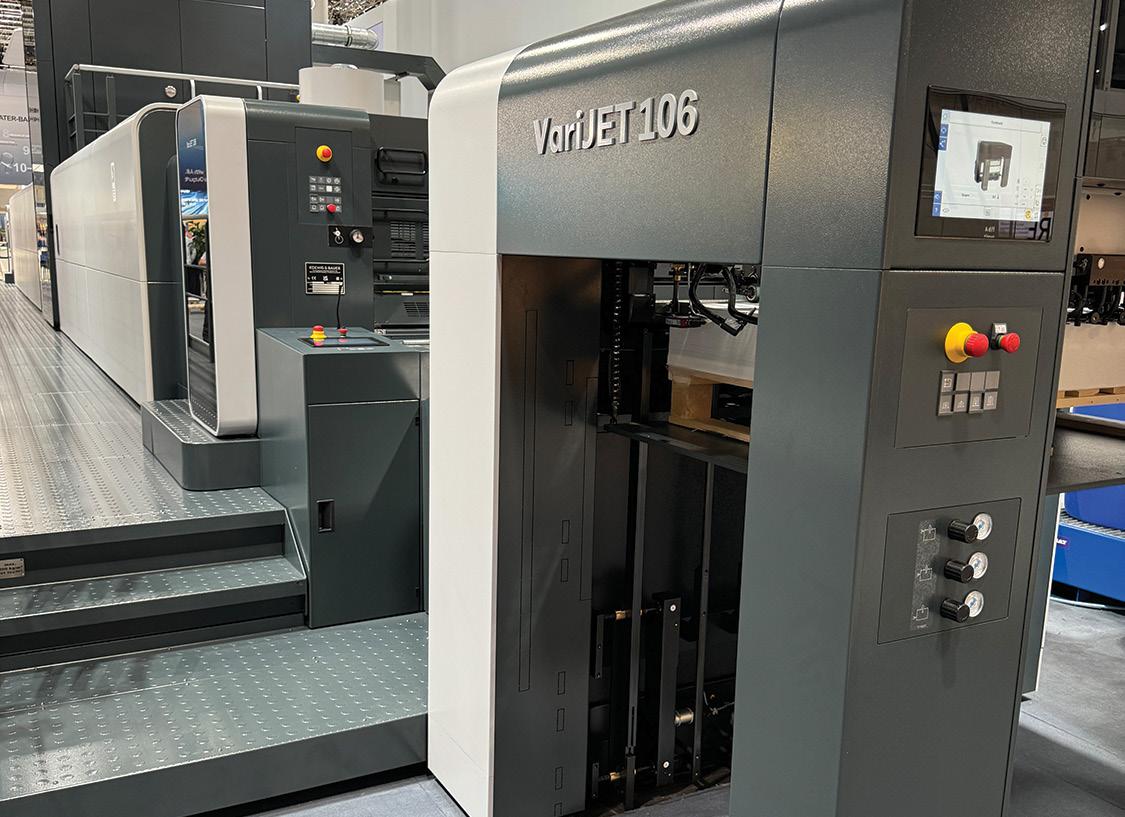
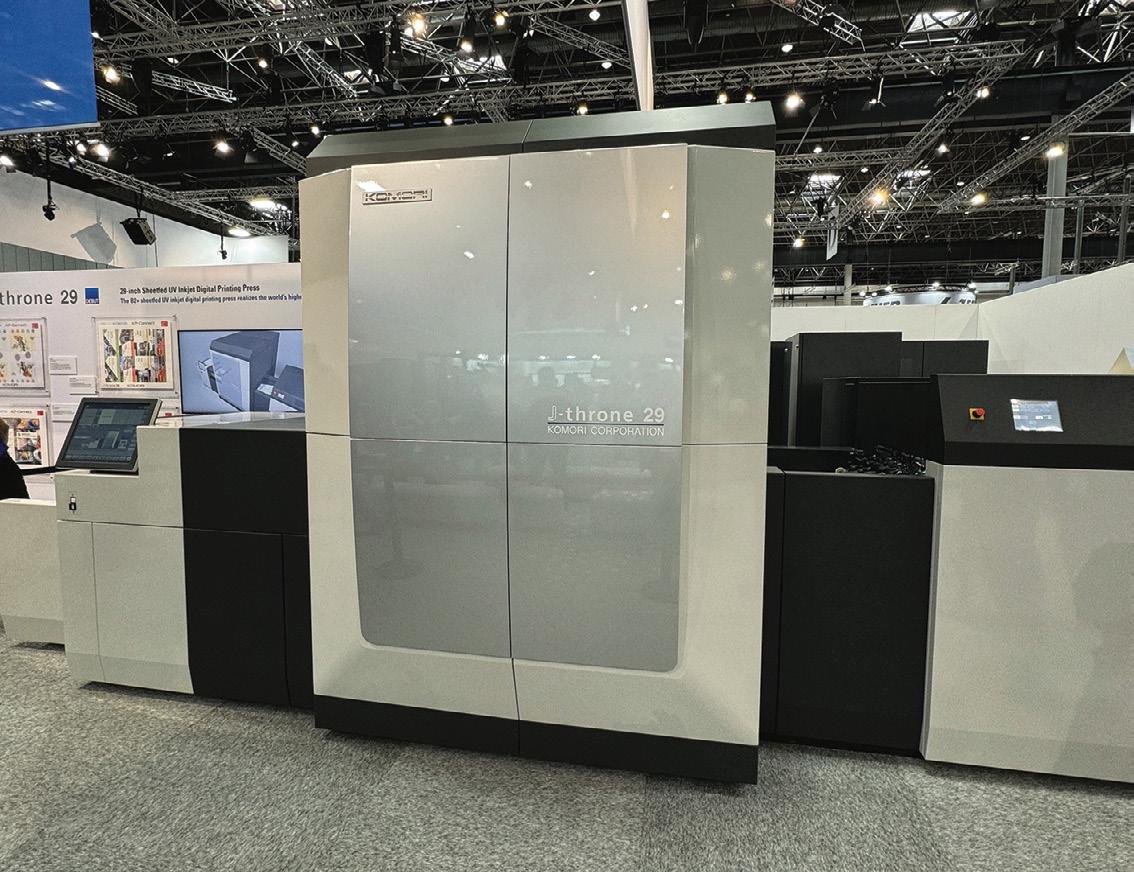
The B2+ Komori J-throne 29 made its debut at drupa and runs at a rated speed of 6,000 sph in single-sided printing and 3,000 sph using the perfecting mechanism. The J-throne 29 used a newly developed UV ink providing printing capability on a wide range of substrates without pre-treating at resolutions of 1,200 x 1,200 dpi.

The Accuriojet KM-1e B2+ prints in four colors at speeds up to 3,000 sph in simplex or 1,500 sph in duplex mode, at a print resolution of 1,200 x 1,200 dpi. Using patented UV ink technology, the KM-1e prints on many types of coated and uncoated substrates, including textured papers, in thicknesses up to 0.6 mm simplex and .45 mm duplex.
This is more than a press—it is a print factory, which both prints and finishes. Equipped with the Memjet DuraLink inkjet printheads offering a resolution of 1,600 dpi, the B1 MGI AlphaJET combines water-based inks, UV varnish, and metallization effects enabling the production of many printed products on a range of substrates (paper, cardboard, and corrugated board.) The sheet system processes up to 2,400 sheets without changing palettes.

The RICOH Pro Z75 is the world’s first four-color, aqueous pigmented ink B2+ automatic perfecting (auto-duplexing) sheetfed inkjet digital press, with resolutions of 1,200 x 1,200 dpi, running at speeds up to 4,500 sph in simplex or 2,250 in duplex/perfecting printing. The Z75 prints on coated, uncoated and inkjet-treated stocks. A gripper-to-gripper transport system provides precise front-to-back registration.

BY RALF SCHLÖZER
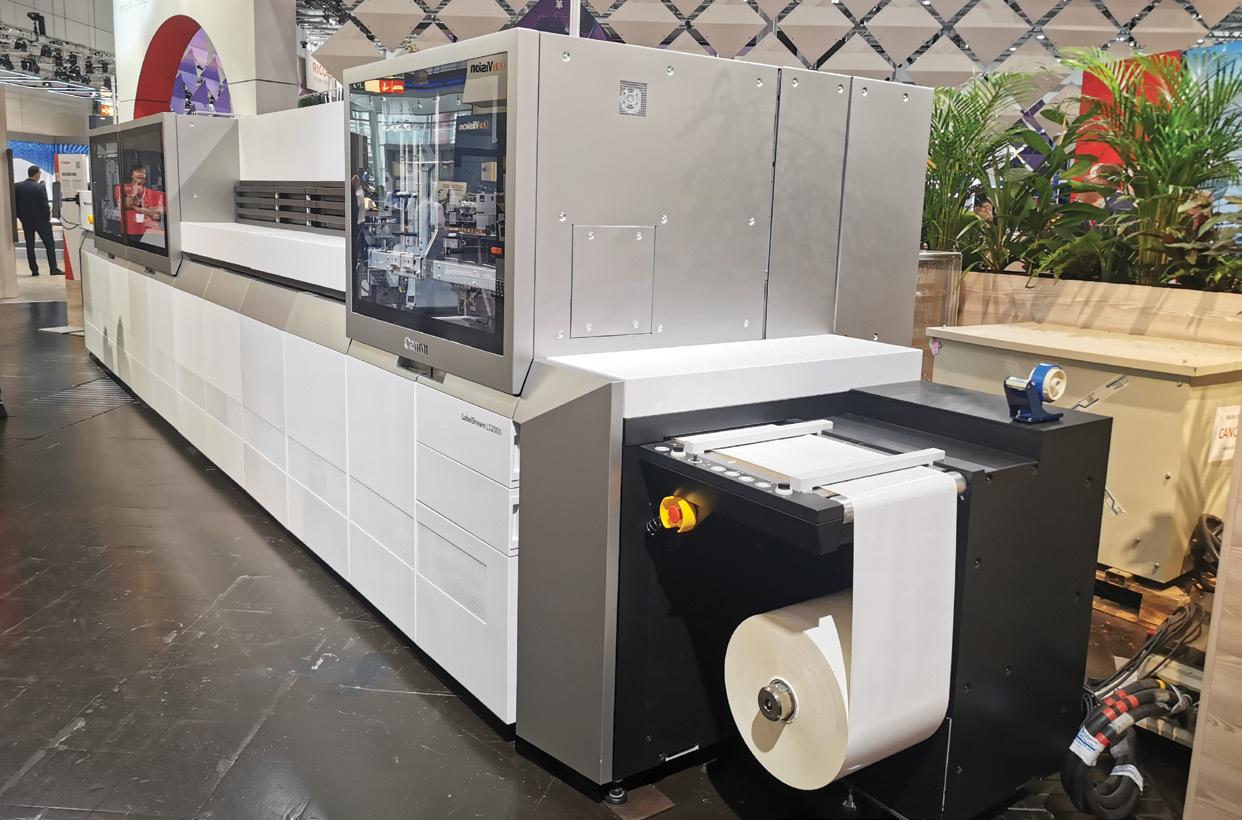
Digital print is already an established technology in label printing. Labels proved to be a fertile ground for digital print due to a smaller format than other package printing, a higher portion of shorter runs than in other packaging markets and a substrate that is generally easier to handle.
Pressure-sensitive labels can be produced by almost any digital printer. However, feeding by sheet is time-consuming, the substrate choice is limited and further processing is more complicated. Despite the ongoing investments in label presses, the total share of all pressure-sensitive labels printed digitally is still relatively small, amounting to just over 6% of all prints.
There is no shortage of dedicated label printing press vendors. More than 30 players offer label printers, often with multiple models in the line-up. Compared to other packaging markets this choice can get bewildering.
Electrophotographic (EP) presses started to address labels in the 1990s, either as liquid toner or dry toner technologies. Accordingly, the technology had a head start but only a few players offer full-production EP printers to this date while inkjet options mushroomed. Still, inkjet accounts for only 20% of the digital printing label volume, according to IT Strategies, although that share is expected to increase.
Originally, inkjet grew on compact press designs and fast speed while offering a lower quality. The quality improved considerably in recent years, however. Considerations when selecting the imaging technology are:
• Inkjet has noticeably faster printing speeds for similar investment sums.
• EP tends to have finer details and smoother blends, especially when compared to 600 dpi inkjet. With higher-resolution inkjet heads, the differences are small.
• UV inkjet has a glossy appearance, which might be desirable for some applications, but can be objectionable for others.
• UV inkjet creates a raised surface, which can create a tactile effect, while aqueous and toner prints are essentially level.
• Inks are more abrasion and chemical-resistant than toner (with the exception of Xeikon’s new UV-hardening TITON-toner).
• Some substrates work better with toner, some better with inkjet.
• Inkjet presses have an easier build and tend to require less maintenance than toner presses.
Comparing costs can be a contentious issue. Some EP presses have click models, while inkjet ink is usually charged by consumption. Comparing ink prices by the liter is not helpful as ink consumption for a given image can differ by device. It will be necessary to assemble a basket of typical motifs and make a calculation based on the ink consumption and extrapolated costs.
Inkjet label printers exist from the smallest desktop model to full-blown hybrid production lines, making comparisons difficult. There are four categories of devices, although placing devices into a certain segment is not always clear-cut. A rough guideline is in the table at the top of the following page.
The choice in inkjet presses allows shops to start small and grow with demand, even for newcomers to label production or goods producers starting to print.
Established label printing plants probably want to offload shorter run jobs from analog presses and require the productivity of high-volume or hybrid presses. The higher-end presses tend to have lower running costs as well.
In any case, there is no best technology and it is all about the application requirements. Several printing companies are even using multiple technologies to offer the best solution.
Types of inkjet label presses
Segment Technology Characteristics
Entry Level Mostly Aqueous Inkjet
Mid-volume UV inkjet
High-volume UV Inkjet
Hybrid UV Inkjet and flexo
• Thermal inkjet heads, often from Memjet
• Speed mostly up to 20 m/min.
• Typically CMYK only
• Compact footprint
• Low investment
• Not designed to run multiple shifts
• Speed: 50 to 70 m/min.
• Typically offer white, sometimes additional colors
• 200 to 360mm web width (approx. 10 to 13 in.)
• Designed for 2 shift use
• Speed up to 100 m/min.
• 330 to 360mm web width (around 13 in.)
• Offer white, often additional colors available
• Occasionally integrated finishing available
• 2 or more shift use
• CMYK inkjet + flexo or other analog processes
• Integrated finishing available.
• Usually as standalone inkjet printer available
• Often wider web widths available as option
• 2 or more shift use
User types
Small printshops and distributed print
Small to mid-size printshops
Mid to large printshops
Larger printing plants

BY ELIZABETH GOODING
While productivity, print quality and cost typically top the list of criteria for evaluating inkjet presses, the size of the press also matters. The cost to rent industrial commercial space in much of Europe has reached record highs according to global commercial real estate services firm Cushman & Wakefield. In the U.S., national rental rates are down from last year, but many urban areas have seen increases of 2–10% despite the large number of remote workers. When space is at a premium, the amount of space required to house a press and related finishing becomes even more important than the simple consideration of “will it fit?”
Kyocera TASKalfa Pro 55000c SRA/3+ sheetfed graphic arts press
Even for companies that own their building, the press footprint matters because it impacts the layout and logistics of the print workflow. For example:
• Can the press be configured with automation equipment like feeders, stackers, winders and splicers in the space available?
• Will other equipment need to be moved to accommodate the press?
• Can the press be positioned so that an operator can manage more than one piece of equipment?
Inkjet press buyers today are paying more attention to the footprint of the equipment and OEMs are responding. The phrase “more compact” has been highlighted in many announcements this year. While we have seen smaller dimensions on inkjet equipment ranging from Canon’s LabelStream LS2000 label press to Epson’s latest direct-to-fabric printer, the Monna Lisa 13000, there have been multiple announcements of new graphic arts presses that emphasized their smaller stature.
Graphic arts presses that must support heavy ink coverage on coated stocks, often have a relatively large footprint due to the drying power required. Once these presses overcame the major roadblock of coated stocks, efficiency, including the economics of the press footprint, has become the next hurdle to clear.
Several of this years’ new rollfed graphic arts presses tout smaller size as a benefit. Ricoh has noted that the new flagship Pro VC80000 press is more compact than its predecessor the Pro VC70000, and more productive at the same time. Canon has launched a ProStream 2000 series that is 20% smaller than the ProStream 3000 series, reducing the press size by two meters with similar speed capabilities. The new ink formulation that reduced drying requirements and enabled the smaller footprint can also be applied to the ProStream 3000 series to enable higher speeds.
Sometimes the base footprint doesn’t tell the whole story. Continuous presses with more configuration options are also trending, particularly with respect to drying and cooling systems. Depending on color, print coverage, and media requirements some presses may be both suitable and available in a more compact configuration.

The HP PageWide Advantage 2200 was designed as a more compact press than its predecessors and to be more easily configurable. HP removed half of the printbars and moved many components outside of its iconic arch design which served multiple purposes. The drying and active or passive cooling units now occupy the same size cabinet offering standard “blocks” for configuring the press. There is a quite substantial difference of 14 meters (47 feet) between the longest and shortest options.
The Kodak Prosper Ultra 520 also highlights its configurability. It offers two named configurations, the 520P for publishing and 520 C for commercial, graphic arts work but additional options are available with various levels of NIR drying adjusting the length of the press, its relative running costs, and suitability for specific application types.
The most compact graphic arts presses among the new releases are naturally in the smaller SRA3 and B3 format. Canon was one of the first to market with B3 format presses, the varioPRINT i200 and i300 Series. These were followed by Canon’s varioPRINT iX 2100 and 3200 Series but none of these could be described as compact. At over 25 feet long, Canon’s B3 presses are substantially larger than B2 format presses such as Konica Minolta’s AccurioJet KM1-e UV press, which does not have the drying requirements of an aqueous presses, and only 25% larger than the new Ricoh Pro Z75 aqueous press which does.

Canon’s newest model, the varioPRINT iX1700, while not truly compact, is much smaller than the previous varioPRINT models. The press will use new, water-based polymer inks and pretreatment to enable 2400x1200 dpi resolution on coated and uncoated stocks at speeds of up to 170 A4 images per minute. It also features Canon thermal printheads as opposed to the Kyocera piezoelectric heads used in previous models.
Speaking of Kyocera, the company described their production printing development strategy at drupa 2024 as “Small footprint, big potential” and has been successful in delivering truly compact, and high powered inkjet solutions. Kyocera’s first press, the TASKalfa Pro 15000c met a market need for a highly productive press with a small, configurable footprint but did not have the color levels or coated paper compatibility needed to compete in the graphic arts segment.
When it comes to market later this year, Kyocera’s second press, the TASKalfa Pro 55000c, will break the coated stock barrier using Kyocera printheads and Screen SC+ inks without the need for primer. The press will run at 146 images per minute on media weights up to 400 gsm. Screen will also be introducing their version of the press, the Screen TruePress Jet S320 in 2025 further expanding options for companies seeking a compact inkjet footprint delivering graphic arts quality results.
BY PATRICK HENRY
The 9th drupa Global Trends Report was notably upbeat about the outlook for print markets served by offset lithography.
“While positive forecasts might be expected from Packaging and Functional printers, what was pleasing was the increasing confidence amongst Commercial and Publishing printers,” stated the November 2023 report, based on input from more than 600 printers and suppliers.
“The resilience of sheetfed offset print volume across all markets is remarkable,” the report went on to say, noting that sheetfed offset has remained the first investment choice for print technology globally since the first Trends report in 2014.
If the question is how offset lithography has managed to retain its preferred place amidst all the technological change the industry has seen, drupa 2024 was a showcase of answers. The solutions on display revealed a method of printing that bears little resemblance to what it was 20 or even ten years ago.
Central to this is the fact that offset lithography now stands as a digital printing process in its own right. All of its main press functions are data-driven and digitally controlled. It is increasingly geared to short runs. In production without variable data, only the way offset transfers ink to paper distinguishes it in any meaningful sense from non-impact digital printing systems.
What’s more, offset printing has become part of a surrounding ecosystem of networked print shop operations that work in unison.
That means no more silos—now the workflow can be seamlessly interconnected from end to end. During the run, print quality is continuously monitored and adjusted for an optimal result. Everything is tracked by the plant’s MIS/ERP for data analysis that can point the way to even better performance next time.
The benefits of 21st-century advances in offset lithography are being reaped in pressrooms around the world every day. Chief among them:
How has offset lithography retained its preferred place amidst all the technological change the industry has seen? We found the answers at drupa.
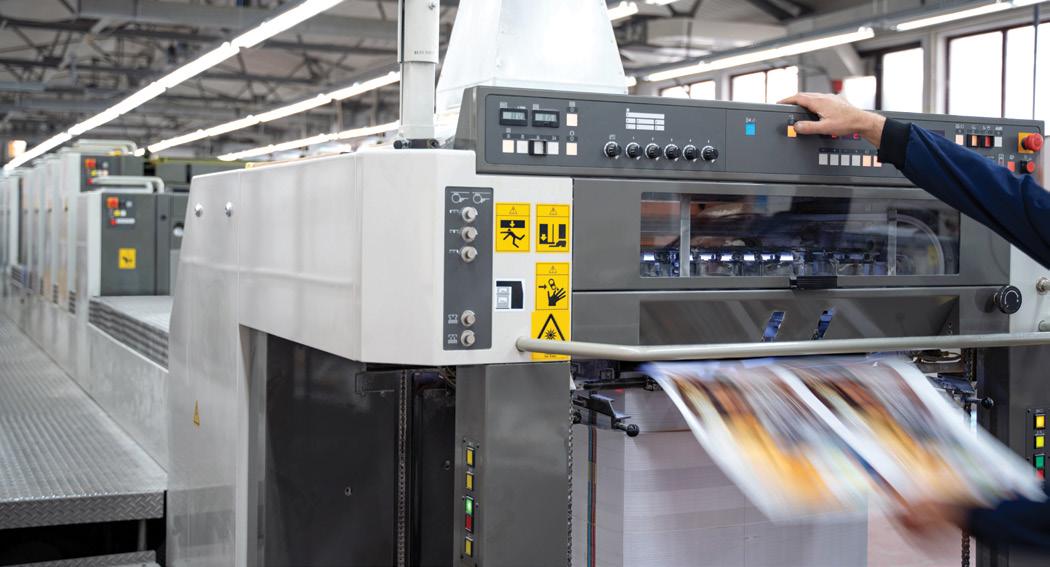
• KPIs—measured as net output, makeready time, makeready sheets, color stability, waste and hours available for production—improve across the board, as does OEE.
• More consistent production means less waste, fewer steps and touches, reduced cost and larger numbers of sellable sheets on the floor.
• Lead times decrease, enabling shops to be more responsive to changes their clients want.
• As efficiency grows, shops can operate more profitably in a short-run, frequent-changeover environment.
But perhaps the most important advantage of all lies in the way modern offset lithography changes the nature of the work that press operators do.
The offset presses presented at drupa 2024 were highly self-sufficient machines that do not depend—or depend only to a small extent—on the skills of people. Because software enables the press to make and execute key production decisions with high speed and unvarying accuracy, operators no longer have to “chase” quality through interventions of their own. That lets them be more productive, less stressed and better able to excel at their tasks even if their conventional press experience is limited.
Simply stated, the more the press can do on its own, the better off everyone working with it will be. This kind of manufacturing autonomy keynotes everything to be seen under the heading of offset lithography at drupa 2024 and at the upcoming PRINTING United.
BY PATRICK HENRY
The elements of workflow have become standard features in the operating systems of lategeneration, digitally controlled offset presses.
As we look back at drupa 2024, the question naturally comes up: what was the single most significant area of advancement for printing technology that visitors encountered at the show?
The answer depends to a large extent on what visitors had come specifically to see, and at an event the size of drupa, seeing everything that could be called game-changing is all but impossible. However, those who were there to learn about the latest developments in offset lithography can’t be blamed for thinking that the process may have started to pull ahead of other kinds of printing in terms of technical improvement.
This is because offset lithography, an invention of the 19th century, has made a huge leap into the present one by virtue of press automation.
When digital printing systems first started to appear 30 years ago, they were already automated— it was the nature of their function and design. On the other hand, offset, a complex mechanical process, had to be entirely reinvented as a form of self-driven manufacturing.
With many more moving parts than a digital press, an offset press had that many more parts to automate—a mandate that the offset press manufacturers had no choice but to fulfill if they wanted their equipment to remain competitive amidst the industry’s shift to toner- and inkjet-based production.
drupa 2024 was a testament to how admirably the manufacturers have succeeded at their task. Although offset presses may have been outnumbered by digital presses in the exhibit halls, nothing at drupa exceeded them for technical ingenuity or, more important, for the quality, consistency and profitability of their printed output.
For some time now, the offset manufacturers have been promoting their presses as autonomous platforms that essentially can run themselves in job after job with minimal human involvement. These claims are mostly true.
Operators still need to oversee what happens in a pressroom, but in plants with the newest offset equipment, changing plates, adjusting ink keys, washing blankets and inspecting pulled sheets are no longer parts of their routine. All of these steps take place automatically in response to instructions provided by workflow software that also collects running data to be used as reference points for future jobs.
Nowhere is the progress of press automation more apparent than in the tools for quality management that are built into the framework of a new press. Inline inspection systems scan every sheet for problems with color and registration and apply corrective action automatically. Some presses can gather and automatically eject flawed sheets from the rest of the run. Waste and spoilage, once necessary evils of offset production, are fading from memory thanks to what automated production has accomplished.
The press manufacturers, like many other vendors, are promoting artificial intelligence (AI) as the next wave of development in machine automation. Exactly what AI means in the context of print production needs to be clarified, but there seems to be no question that offset presses can learn from the volumes of data they generate themselves and the information that they draw from other nodes of production in the plant. Job scheduling, quality management, and predictive maintenance are AI-assisted press functions now. More will follow.
Although automation has transformed the machines, transporting the industry as a whole to fully automated production will take longer. The powers of press automation as seen at drupa are available to printers who are ready to make an investment in the newest press equipment—a step not every printer is in a position to take. Numerous stands at drupa offered
solutions for adding automation to legacy equipment on a limited scale, an acceptable alternative for shops with constraints on what they can invest.
But in the long run, gaining the efficiencies and economies of press automation will be imperative for every shop that wants to keep its place in an industry where profit margins on most kinds of work will never be greater than they are right now, and where the competition for that work will never be less.
The advice to these businesses is to take the press manufacturers seriously when they promote automation—and to interrogate them closely about how the benefits of automation will be realized in the day-to-day operation of the plant. The lesson of drupa 2024 was that the opportunity is there to be seized— and should be seized without delay.
BY MARK VRUNO
At this year’s drupa, manroland Goss, a leading supplier of web offset printing and digital finishing solutions, presented a wide range of innovations and solutions that sustainably advance the future of the printing industry. Under the motto “WE ARE PRINT. WE ARE WEB OFFSET. WE ARE MORE,” the German machine manufacturer underlines its pioneering role. The overarching focus is on saving resources and increasing efficiency.
• Variable-format pin folder increases application flexibility and production stability in book printing.
• AI-based maintenance platform MAINTELLISENSE increases productivity in print production.
A cutting-edge development for book printing is being introduced by manroland Goss. Its variableformat pin folder has been specially designed for its application in book printing. It is optimally tailored to the increasing requirements in a dynamic market environment. This technology enables the efficient processing of different formats, even for short runs, and significantly strengthens the competitiveness of customers through improved flexibility and efficiency in book printing.
The printing press manufacturer also presents another product highlight in the area of digitalization: MAINTELLISENSE, a predictive maintenance platform that stays one step ahead of potential problems thanks to “intelligent” data analytics. drupa visitors experienced how MAINTELLISENSE uses AI-based anomaly detection to optimize machine maintenance,

detect impending machine downtimes at an early stage and help solve problems. The smart software enables faster and targeted decisions for more efficient and sustainable print production.
Finally, with a wide range of professional retrofit and upgrade solutions, manroland Goss serves as a full-service provider and specialist for web-offset printing systems. The company supports customers in bringing their production systems economically up to date. From mechanical and electrical engineering to software development, manroland Goss offers extensive in-house solutions, not only for its own brands but also for others, even for printing press relocations.
In addition to commercial and newspaper printing, booth highlights came from the world of packaging. VARIOMAN, with web-offset technology, is a gamechanger for package printing, enhancing efficiency and sustainability.
BY PATRICK HENRY
Komori had made a major commitment to drupa with a 14,500-sq.-ft. stand that presented three pieces of equipment in live operation. The theme was “Connected Automation”, which Komori describes as the process of linking all equipment within printing facilities to achieve enhanced visibility, automation, and efficiency in production processes. This is made possible by KP-Connect, Komori’s cloud-based system for monitoring plant and equipment performance.
The stand featured individual zones for commercial printing, digital printing and packaging, with KPConnect keeping track of the presswork taking place in each demonstration.
Anchoring the commercial zone was a Lithrone G37P advance EX Edition (GL-837P-A), a 37-in., eight-color convertible perfector with H-UV L (LED) curing. Komori said that the autonomously-running press can start itself and come up to color and registration in about 70 4/4 makeready sheets. During the run, AI assistance alerts the operator to printing issues and recommends corrective action.
As part of the commercial demonstration, an Autonomous Mobile Robot (AMR) transported printed sheets to an MBO folder equipped with its own robot for offloading folded signatures to the AMR. The mobile robot then shuttles the signatures across the aisle to Komori subsidiary MBO Postpress Solutions for binding on a Hohner saddle stitcher.
A world debut in the digital printing zone was J-throne 29, a B2 sheetfed UV inkjet digital printing press that joins the Impremia IS29s and Impremia NS40 in Komori’s digital portfolio. With printing speeds of 6,000 sph single-sided and 3,000 sph double-sided, the J-throne 29 is scheduled to enter beta installation testing at the end of the year or in the first quarter of 2025.
The platform for packaging is a Lithrone GX40 advance EX Edition (GLX-740A+CC), a UVequipped, 40″ seven-color sheetfed press with inline double coater. Komori says that thanks to its CMYK + OGV color gamut, the Lithrone GX40 can reproduce many branded colors without PMS spot inks. Assets include Komori’s Super Short Makeready and Smart Color features for lowering makeready waste and eliminating print problems.
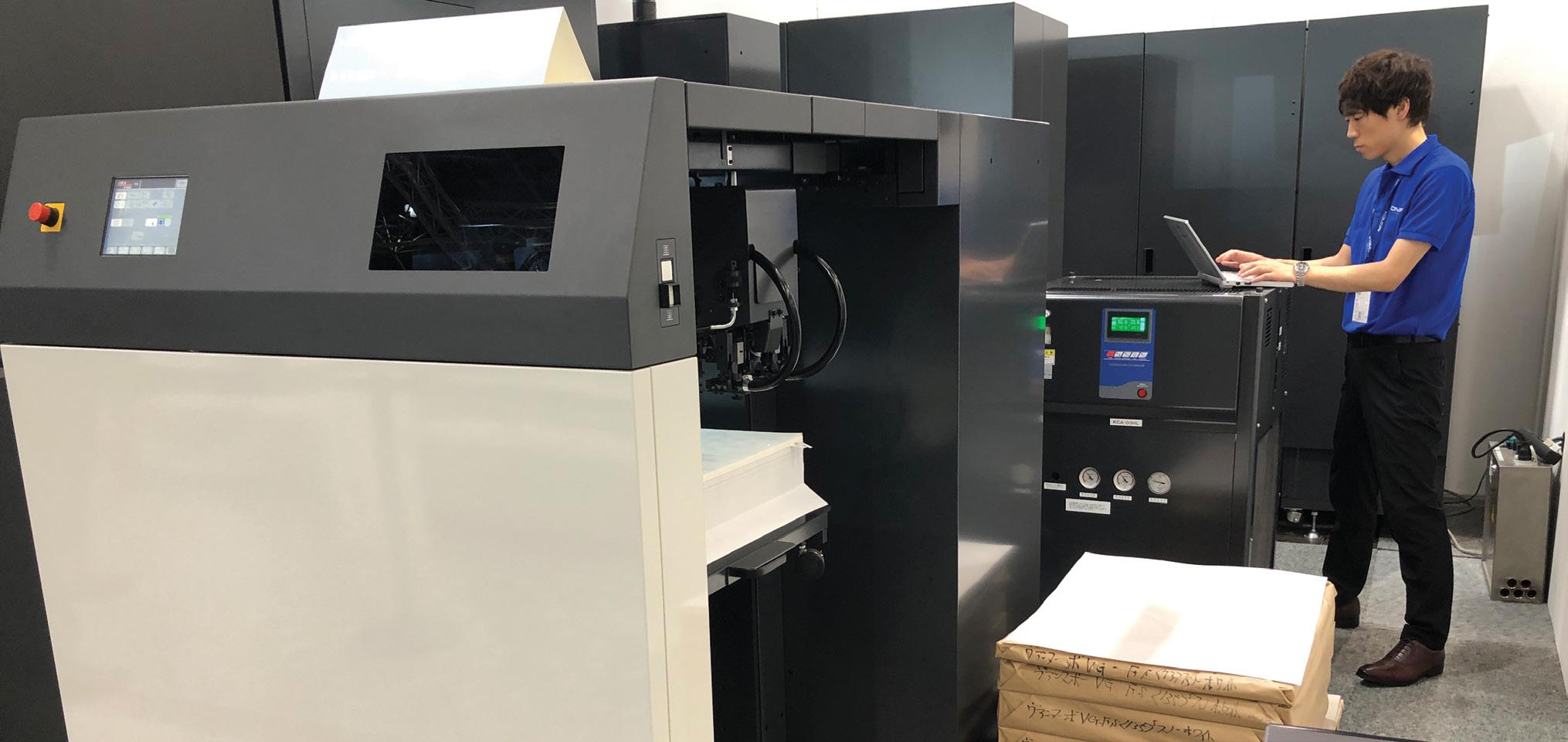
BY PAT MCGREW
Consider the humble book. It has a book block printed on an offset or digital device and is bound to a cover using technologies as diverse as glued perfect binding, sewing, spiral binding or drilling to put into a binder. A growing challenge for book producers is the changing run lengths demanded by publishers and self-publishers. While the bestseller you picked up at the airport may still be produced by the tens of thousands, more books are moving to short-run production across all segments. Your shop may be trying to manage everything from single copy production to mega runs.
Changing needs are an excellent reason to look at the current book-finishing solutions in the market. Every vendor can point to case studies and success stories, but not every shop operates in the same way. When considering book finishing options, start with a walk through your shop and a conversation with your team to identify bottlenecks and sticking points in your finishing. Look at the footprint your current machines occupy and how many people are needed to produce finished goods. If you can isolate the utility cost by machine, that is good data to have in your pocket.
Now, you are ready to talk to vendors. Start by developing a concise description of your environment. Are you a continuous web or cutsheet shop? Or do you support both? Do you print in-house or only provide finishing services? Are you a casebound specialist, or do you support perfect binding and other solutions? How tight are your deadlines? What are your average volumes? Are you considering adding capabilities? Help the vendors you approach by drawing a box around your current environment and the one you are trying to evolve into.

As you look at folding, gathering and collating equipment, look at the machine size. What size sheets do they handle and how many folding types are supported? How many sheet-feeding configurations are available? Is there support for inserting sheets of varying sizes and weights? How hard is it to change set-ups between jobs? Ask about maintenance requirements and data they may have on uptime. Does it communicate with the workflow using a protocol like JDF/JMF? Does the equipment integrate into an endto-end, limited-touch workflow? This becomes more important as runs are shorter, deadlines are tighter and dashboards help keep the shop on time.
Binding technology continues to improve, with more book sewing and gluing options than in years past. Machine footprints can be smaller due to micromotors and intelligent book paths inside the equipment. These innovations can bring value to a shop by reducing the amount of floor space for the machines, freeing space for more equipment to add capacity. Newer machines tend to be more energy efficient, too. Ask about options for eco-friendly glue.
Look at the binding styles available. Does the equipment support extended flaps on covers? How many sheets can be included in a book? For casebound books, look at how endpapers—the double sheet of paper inside the cover—are handled and if there are weight limits on endpaper stock. Speed is also a consideration, so ask how long it takes to move between book formats.
Look at the trimming options available. This is another space where innovations have added options and speed. Ask about maintenance, average knife life and the cost of consumables.
Dig into the cost of consumables and repair strategy in every conversation. Machines do fail at times. How long will you wait for service? Is it local, or do repair people have to travel to your city? Are replacement parts readily available? What is part of the available service contracts, and what would be an extra cost? Is there an additional cost for service outside of regular business hours?
With these questions, you are ready to launch on your adventure. Be prepared for the unexpected, keep your eyes open and don’t forget to talk to other printers along the way.

BY PAT MCGREW
Timm Edelhoff, head of Horizon GmbH in Quickborn, Germany, takes a pragmatic approach to automation. Under his leadership, Horizon GmbH embraces the smart factory concept to leverage technologies that streamline operations, enhance productivity, and deliver customer value. It was all on exhibition in their drupa stand in and partner stands in Düsseldorf.
Edelhoff's philosophy on automation is clear: technology should serve a purpose beyond novelty. "Automation must have a customer benefit or ROI," says Edelhoff. "Technology without a direct benefit is a waste of effort and will not contribute to your success." This practical approach is reflected in Horizon GmbH's implementation of AI-based systems in its warehouse operations. "By linking AI with our ERP system, we've streamlined administration time and
improved customer interaction," Edelhoff explains. "This integration helps us deliver the correct part at the correct time, place, price, and form."
Another example in the Horizon factory is the selfdriving cleaning robots in its showroom and factory to reduce costs and free up human resources for more critical tasks.
The introduction of the Horizon BQ-500 perfect binder extends the vision with Horizon's new cloudbased iCE LINK workflow and job-management tool that features 21 automated sections, advanced visual monitoring, and the capability to handle variable production at speeds of up to 800 books per hour. "The BQ-500's advanced automation and customization options make it the most productive binder for bookof-one production in its class," says Edelhoff.
Edelhoff's approach aligns with broader industry trends that see small to medium-sized enterprises (SMEs) adopting smart factory technologies to gain significant improvements in operational efficiency and productivity. He also cautions, "We must do what makes sense for our customers and our company. Automation should provide a return on investment and improve customer satisfaction."
Looking ahead, Edelhoff envisions the evolution of smart factories into dark factories — fully automated operations that run without human intervention. "As we look into the future of automation, robotics, and AI, I see smart factories becoming dark factories," he says. "This will bring significant improvements in customer satisfaction and ROI for manufacturers and their customers."
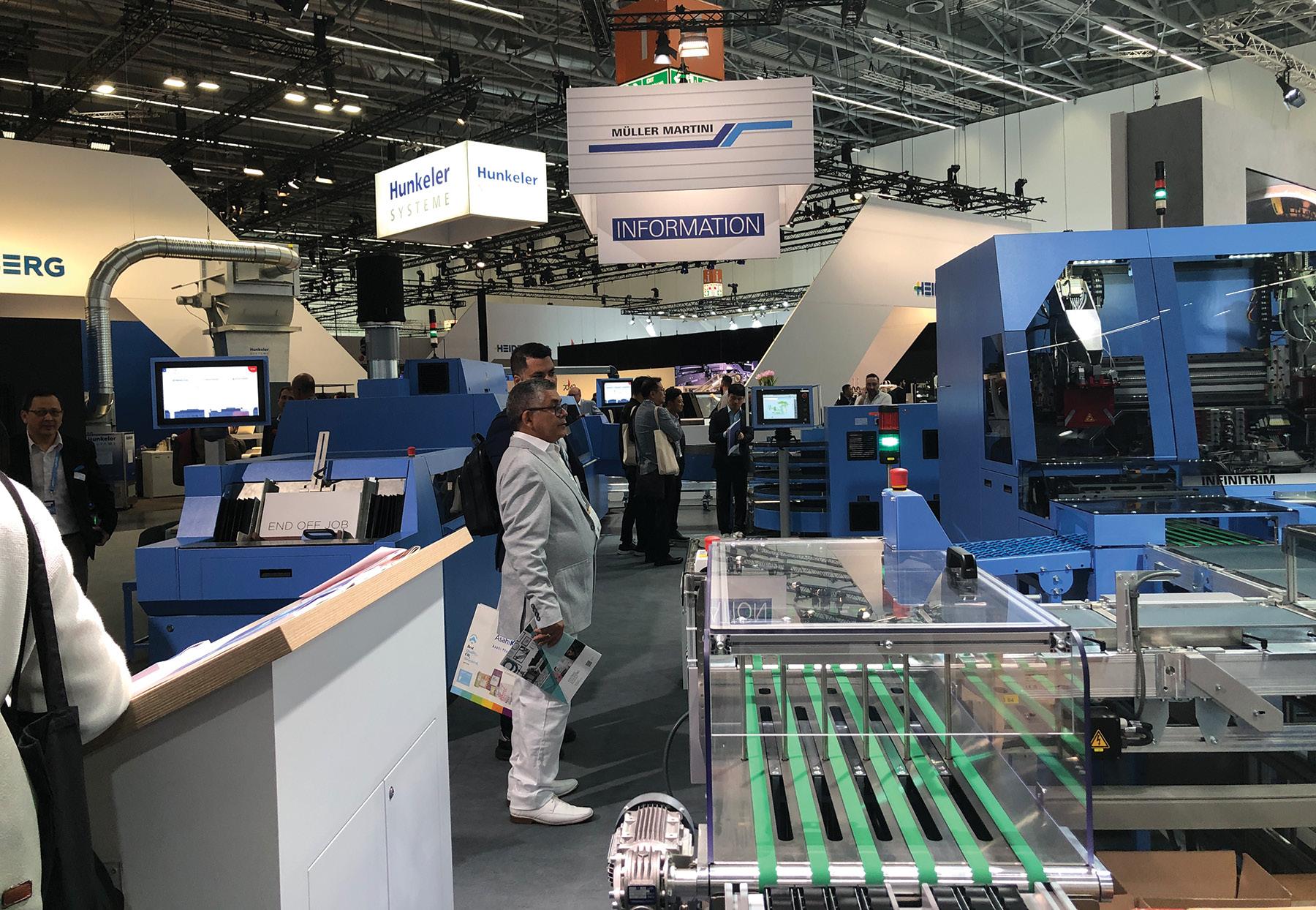
BY PATRICK HENRY
drupa 2024 was the first opportunity for Müller Martini to exhibit in parallel with Hunkeler Group, with which it merged in December of last year. At a media briefing during the show, Müller Martini CEO Bruno Müller updated the partnership between two of the industry’s premier suppliers of post-print paper processing solutions.
Müller said the goals of the merger are to preserve the companies’ respective strengths and to help them avoid interfering with each other in the product areas where they specialize. He added that the businesses— both family-owned, and both based in Switzerland—are equally focused on driving the digital transformation of printing and on serving as strong partners for their customers.
Remaining the same, Müller noted, is the commitment to presenting Hunkeler Innovation Days, a well-known trade exposition for digital printing. The event’s next edition will take place from February 24 to February 27, 2025, at the Lucerne Exhibition Center.
Müller observed that the joint venture is moving forward in an industry confronting challenges that oblige it to find new ways of doing business. Among them are pressure to operate more sustainably, persistent labor shortages and growing demand for individualized products. Print volumes continue to decline, but with the smaller quantities consisting of an increasingly diversified array of titles.
All of this points the two companies more strongly in the direction of solutions for digital production, according to Müller, who pointed out that 50% of their combined equipment business is now driven by digital printing. For example, in book publishing, a market they both serve, large volumes are shifting away from conventional production to digital inkjet.
Müller Martini began digitizing its manufacturing 20 years ago with the introduction (at drupa 2004) of a CIP4 JDF/JMF compliant workflow for its SigmaLine book production system. At drupa 2024, Müller Martini and Hunkeler coordinated their efforts to present “Smart Factory” solutions for networked, fully automated post-print processing.
The concept was illustrated at the Müller Martini stand in two live demonstrations: one of SigmaLine Compact with the Antaro Digital perfect binder; and another that pairs Hunkeler’s Starbook Sheetfolder with Müller Martini’s Vareo PRO perfect binder.
BY PAT MCGREW

Print-and-mail companies balance client production requirements and regulations from postal authorities in the countries where they operate. There are classes of mail based on purpose (bills, statements, marketing, periodicals), size and weight and anticipated speed of delivery. Discounted postage rates may be available based on presorting and other programs. It is a complex business, but software and hardware solutions can add efficiency to the workflow.
Before talking with vendors on your research journey, review your current equipment and the physical workflows supporting mail processing. Are machines logically arranged? How many people are involved in operations? What is your equipment mix? You may find that some machines have automation and reporting features, but some are older and require manual effort. Take stock of what you have and envision what more automation, faster equipment and more reporting could bring to your shop.
For this journey, the focus is on the hardware and if it is appropriate for your needs. Are you a low-volume shop focused on hand-fed systems, a mid-volume shop using more automated equipment or a high-volume shop processing thousands of envelopes?
Review your physical workflow. Are you working from printed rolls or sheets? Do you use roll-to-cut devices? How much configuration flexibility do you require to support the products you mail?
Consider how you insert sheets into envelopes. What size sheets do you support? What weight are the sheets? What texture? What size envelopes are supported?
Once inserting is done, what types of sealing are required?
• Flaps Closed Sealing: The flaps are down, so the machine opens the flap and moistens it for pressure sealing.
• Flaps Open Sealing: Envelopes are put in the stacker/feeder on top of each other. This less popular option allows you to run sealed and unsealed mail together.
• Flaps Open and Closed Sealing: The most versatile option, these machines can seal with the flaps open or closed.
Sealed envelopes may still need another step before they are ready to be lodged with the postal system. Do you require equipment that can add print to the exterior of an envelope? The print could be any combination of postage, marketing messages, addresses, and mail tracking barcodes. Do you require black printing only or full color?
Do you require equipment that can weigh each piece, signal on overweight pieces, and provide summary and transaction data? Do you require piecelevel tracking using camera systems and scanners? Will you need the ability to gather data and feed external tracking and dashboarding systems?
How fast do you need the system to process the mail to meet Service Level Agreements (SLAs) and other deadlines? Talk to vendors about their processing speeds and what happens when you need to vary the size and shape of envelopes in a single production run. If you run in line with your presses, what is the top speed of your current equipment, and does your mail processing line keep up with the current available speeds?
In high-speed processing, most systems support automatic feeders and stackers. Ask about how much variation in a batch is supported in terms of envelope size and weight. Ask about new options for camera systems used in address verification, and quality and feeding audit data to primary piece-level tracking systems. Most high-speed sorters support automatic feed alignment and have internal scales, making it possible to run letters of different sizes and weights and flats of different sizes and weights together. Talk to vendors about your stacking requirements, and don’t forget to investigate the new generation of robots and cobots that can grab stacks of sealed envelopes and place them into the mail trays. These solutions remove people from the process, freeing them for other work. They never call in sick and represent a fixed cost to the operation.


Each of these systems has dozens of moving parts and parts that wear. Ask about maintenance routines, anticipated maintenance downtime, and consumables. Do they support remote-guided repairs? How long does it take to get service if a machine fails? Is it local, or do repair people have to travel to your city? How long does it take to get spare parts? How do service contracts work? Is it possible to train your staff to do self-maintenance?
Build your list of questions, and don’t be afraid to go off-script as you learn. Investigate recommendations from the vendors you speak with, but also to other printers about how they operate their shops. There are a million variations, and one of them may be perfect for your shop.




BY PAT MCGREW

Machine Learning (ML) and Artificial Intelligence (AI) have been part of the print industry vocabulary for decades. They are sophisticated approaches to developing activity automation that now encompasses content development, design, heuristicsbased profiling, legacy print file regeneration and other valuable developments. ML and AI are based on improving performance and automating tasks but are only two aspects of building workflow automation that bring efficiency to print operations. Integrating diverse threads is an essential element in building an automated print shop. That process requires deep knowledge of the current workflow.
Intelligent Automation leverages technology to automate tasks based on what subject matter experts know. It does not need to be a single effort; the process lends itself to creating automated modules, though the end game is arguably full end-to-end automation. Intelligent Automation can simplify the production of accurate output so the organization can focus on growing the business. It applies in every print segment and type of print organization and can be your first step into bringing efficiency to workflow tasks.
At its heart, Intelligent Automation is the gateway to efficiency. The journey begins with carefully assessing the current workflows, focusing on every task, especially those completely or partially automated. In an ideal situation, you would develop a flow that shows the ways a job can come into your shop, the paths a job can take, the people who touch it, the loops and turns it may take common bottlenecks and the most common places for mistakes to enter the flow. Who is involved in each task and who is their backup? How much job
management is done in hallway conversations, emails and online chats? These are the guideposts. Break the process into the tasks and people involved in onboarding jobs, preparing jobs, producing jobs, and closing the loop to ensure accurate invoicing. Don’t forget the change management loops. Job onboarding tasks often start with a high-quality web-to-print solution to capture job specifications, estimate and quote, provide real-time proof and approval and standardize the feeds into the next steps in print production. Each step gathers data that downstream processes can use.
Using software scripts or Job Definition Format (JDF) communication, essential steps are automated based on business processing rules. These rules automate file handling and provide a feedback loop. If data is outside the expected values, the automation protocols can signal that a job needs intervention. As that happens, new rules can be added to handle the conditions of the rogue files. If all is well, it seamlessly moves to the next operation.
The same process applies to prepress and production. The goal is to develop a comprehensive solution set to interpret common data. There are excellent automation tools in the market that allow some degree of automated color management, imposition, nesting and ganging and file transformation to meet output device datastream requirements. When Intelligent Automation principles are applied to existing and new steps, the results are workflows that, over time, can become fully automated, leading to operational efficiencies, reduced operational costs, and higher profits.
BY PAT MCGREW
Four Pees, based in Belgium, established its foothold in the market in 2007. Today, it works worldwide, renowned for its dedication to streamlining print production processes to enable the transition from mass production to mass customization through innovative software solutions. They deliver tools that enhance productivity and improve the integration of print and digital technologies. Four Pees’ mission is to make print operations more efficient, cost-effective and adaptable to the evolving demands of the digital age.
In 2024, Four Pees unveiled a groundbreaking offering, Atomyx Integration Platform as a Service (IPaaS). It promises to revolutionize how printing businesses integrate their workflows and systems, providing a hub where print buyers, sellers and manufacturers connect. The platform is designed to cater to the increasing complexity of print production environments that involve a multitude of software solutions and hardware setups.
The value proposition of Atomyx is being able to profitably produce at scale by making upstream and downstream data sources available to the business and production so it can be insightful and actionable. This takes a true SaaS platform for scalability and adaptability to constantly changing production bandwidth requirements that mass customization faces.
Atomyx differentiates itself with a user-friendly interface that allows print operators to configure and manage integrations without the need for extensive IT knowledge or programming skills. It also changes the investment considerations using by moving to subscription and making integration less technical.

This democratization of technology is a key part of Four Pees’ strategy to make advanced automation accessible to a wider audience within the printing industry.
Four Pees is demonstrating the platform has three main components: Atomyx Manage, Atomyx Prepare and Atomyx Layout, which can be integrated independently or as a complete system. It is cloud-based allowing for scalability without the burden of infrastructure overheads or complex license management, making it a cost-effective solution for print businesses aiming to meet rapidly changing customer needs.
Positioned as a transformative tool for the printing industry, Atomyx promises to enhance how print providers manage and execute their operations.

BY RYAN MCABEE
The label and packaging markets continue to be an attractive market opportunity for print service providers wanting to expand beyond their traditional offerings. Mordor Intelligence estimates the packaging market to reach $1.38 trillion / €1.27 trillion by 2029 with a respectable 3.9% compound annual growth rate. Printers looking to seize opportunities in these markets must also have a robust workflow for seamless connectivity to consumer brands, purchasers of packaging, along with process automation to produce the orders once placed. Esko is a leading developer of software and hardware solutions for labels and packaging industry. It maintains an extensive portfolio of solutions to provide end-to-end automation across packaging’s value supply chain and powers nine of the top ten major global brands.
In Esko’s stand at drupa, visitors were able to see the company’s integrated technology ecosystem highlighting its close integrations with Enfocus, Pantone and X-rite—four operating companies that are part of the parent Veralto’s Product Quality and Innovation segment. Esko introduced sCloud, a multitenant cloud-native platform. This innovative system embraces the latest in cloud computing, data sharing and artificial intelligence (AI). Every Esko application, including ArtPro+, ArtiosCAD, Phoenix, Cape Pack and Automation Engine, will seamlessly integrate with sCloud. This integration ensures that stakeholders across the value chain enjoy continuous access to realtime data and shared resources, regardless of location. Additionally, sCloud is an open platform that fosters collaboration and connectivity with external partners.
A visit with Esko exposed visitors to several key technology trends impacting the greater graphic arts community. The move to cloud-based infrastructure and deployment of software solutions provides greater flexibility in unlocking geographically diverse talent pools and scalability for converters and service providers during peak production periods. In addition to Esko’s sCloud, partner Pantone’s cloud-based ink formulation platform streamlines all aspects of formulation, storage, approval, retrieval and quality control for offset, flexo, gravure and screen-printing inks. Real-world applications of AI were also being shown with the company’s intelligent imposition solution, Phoenix, and through a technology demonstration of a new AI-assisted decision-making tool for upstream packaging project specifications.
BY PAT MCGREW
Built on thirty years of delivering future-ready technology to both industries, eProductivity Software (ePS) offers automated and purposebuilt software technology for MIS and ERP, eCommerce and industry-specific point solutions. ePS is a unique technology provider that designs and deploys purposebuilt solutions globally for every segment in the print and packaging industries across all sizes of business. Going into the third year of independence after the separation from EFI, the company remains committed to continually improving our customer’s experience and empowering them to build and maintain a successful and profitable business.
The newest from eProductivity comes from the Print ePS division with developments across its print MIS and marketing solutions. Nubium, a new cloud-based print MIS for smaller print providers, was debuted at drupa. The solution promotes a preconfigured system for businesses to start creating estimates within the first hour of implementation without the need for high technical expertise. It streamlines various aspects of the print process from estimating and inventory management to integration with financial systems. The latest updates PrintFlow 4D for scheduling and Auto-Count 4D for shop floor data collection were also shown, including the new integration of PrintFlow 4D with Tharstern.
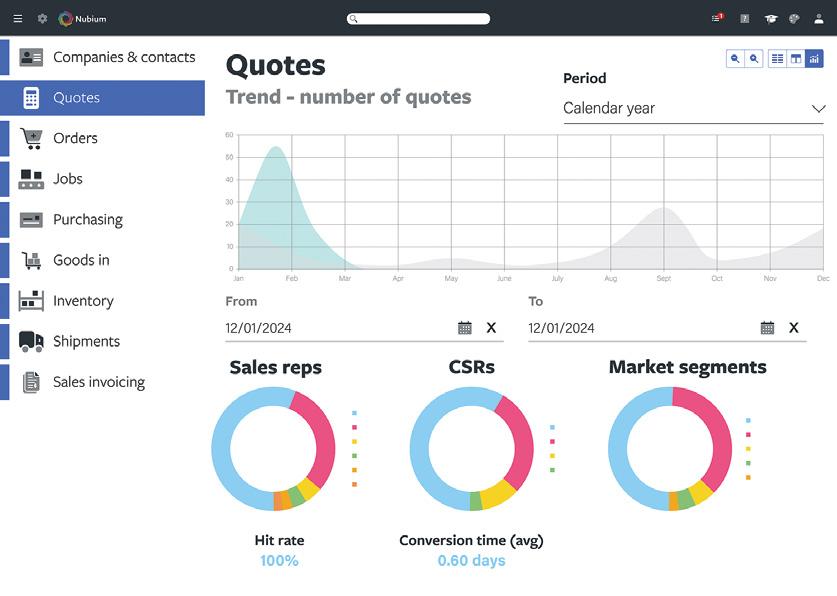
The ePS Packaging division displayed its complete ecosystem of industry-specific solutions for all major segments of the packaging industry: labels, folding carton, flexibles and corrugated. Packaging converters should see the power of automation using eFlow with the flexible ePS Automator technology that provides customers with real industry-specific automation enabled with AI tools. Real-time data and analytics for taking action to improve business operations is possible using a packaging-specific data collection and warehouse management system across the factory floor that enables near real-time tracking of material movement alongside tools for traceability and quality control.

BY PAT MCGREW
When we integrate Intelligent Automation, we leverage the power of Machine Learning and Artificial Intelligence, but much of the automation implemented may not use either technology. Intelligent Automation is often built on programmatic rules written to guide work through the process steps needed to create the products you sell. These solutions bring efficiency and consistency to workflow and may be all you need. However, if you are looking at adding an array of new products connecting to other processes in internal or customer organizations, consider the options AI implementations can bring to the table and the power of Integrated Platforms.
A robust AI implementation goes beyond a library of executable rules. With the rise of Generative Pretrained Transformers – GPT – the options to embed more intelligent AI into digital front ends (DFEs), digital presses, hybrid presses, finishing equipment, dashboards and software tools are vast. GPT-based solutions, whether they leverage a Large Language Model (LLM) or a Multi-modal Model, can perform tasks, interpret data and learn faster than most people. Hardware vendors can pair GPT-based programming with color management and print quality tools, including input from vision systems (scanners and cameras) in real-time, to reduce or eliminate prepress work required to build profiles and minimize reliance on operators catching print quality changes during print runs. Leveraging AI, the press can identify issues, often take needed corrective actions and then inform the dashboard solution of the issues that occurred and actions taken.
Ask the vendors who supply your hardware and software about their AI roadmap. They may tell you they have already incorporated solutions into their machines and solutions. AI can bring superpowers to processes that free people to do more critical or complex work and for vendors, it can help speed the diagnosis of problems and the needed fixes.
Large Language Model: A text-based library that can be as localized as your internal knowledge bases or as global as the internet. AI can understand, generate and manipulate text data when it uses an LLM. They process and produce natural language. They are excellent at translation and summarization. Example: ChatGPT or Read.AI
Multi-modal Model: These models are trained on and can process and integrate multiple data types, such as text, images, audio and sometimes video, enabling them to learn from and correlate information across different data types. These models can perform tasks that require understanding and generating data across different modalities, such as image captioning (generating text from an image), visual question answering (answering questions about images) and audio-visual speech recognition, providing more comprehensive and contextually rich output. Example: CLIP or DALL-E
Another path to superpowers takes the form of Integrated Platforms. You may have heard the term Integrated Platform as a Service (IPaaS). Platforms integrate disparate systems and automate workflows, reducing manual intervention. The goal is to improve efficiency and reduce the likelihood of errors in processes, including order management, production scheduling and inventory control.
The two essential elements of IPaaS frameworks are that they provide unified data access, enabling integration with CRM, ERP, MIS, and other business systems, and the ability to produce real-time insights with that data access. IPaaS solution providers, from the newly launched Atomyx to the team enabling the Esko cloud solution S2, bring the value of integrating diverse data sources, enhancing CRM, and optimizing supply chain and production processes. They help print businesses improve operational efficiency, enhance customer satisfaction, and remain competitive in a rapidly evolving market, regardless of the print segment they serve.
The power of platforms is that they provide scalability and cost efficiency. If leveraging a platform is intriguing, talk to your current software providers about the platforms they may be working with today. Remember that you can begin by bringing in a platform for one workflow or end-to-end process and then grow your implementation over time. The more data the platform shares, the more visibility you have into your processes, gaps, and bottlenecks!
BY DAVID ZWANG
Hybrid Software today has grown organically and through the acquisition and integration of an extensive but synergetic group of companies. This has allowed them to build very complete and efficient solutions for both OEMs as well as PSP users. If we look at the increasing requirements and demands of print production, data is at the heart. It is at the core of the processes, but it can also constrain it as you start to add increased press speeds, resolutions and variable data. These demands require even more significant and costly hardware to keep up with the presses creating a need for server farms. These server farms are beginning to look as big as the press, and add a significant expense to the press equipment cost. Ideally, addressing this issue requires a solution from a company like Hybrid Software that has control over all of the pieces from the core infrastructure to the end user workflow.
So how do you get the data to the printhead with maximum efficiency? Harlequin Direct has accomplished this with desktop class, not expensive higher class, server CPUs using an intelligent data flow as you can see in the illustration on this page. Getting the data to the printhead only addresses part of the problem. How do you process synchronize, inspect and compare all of that content on the fly at press speeds? Global Graphics found that their Mako SDK could be used to help address content inspection requirements where the applications are static data or offline variable data.
The Global Graphics SmartDFE suite was designed to be part of a fully automated manufacturing solution supporting Industry 4.0 telematics and MIS integration, plus connectivity with automated manufacturing lines via standard OPC UA. It brings together the creation of optimized print-ready PDF files; workflow and job automation to connect with enterprise IT systems; RIPing; screening; optimizing image quality; and via Harlequin Direct, drives the print data directly to the printheads at ultra-high speeds through Meteor software and electronics, or through Xitron’s Navigator DFE platform all in one powerful solution. Since SmartDFE uses the OPC protocol, it provides industrial interoperability so it is possible to create a feedback loop from the inspection system that alerts the press which could then be directed to make adjustments, reprint pages and so on.
With SmartDFE, as seen below, you could have four machines for running the different process colors, and a fifth generating an RGB image from the same PDF data to generate a reference image that could be compared by the Visual Inspection System (VIS). Many of the VIS systems use OpenCV, an imaging library, which can be used to compare images and through ML (machine learning), provide the systems with information that can be used to control machines and do it at operating speed. Smart DFE is a bundle of the two products, bringing high performance print production data processing to OEMs. This solution is currently used in the Fujifilm FP790 flexible packaging press and others.

Interesting production products that Inkjet Insight contributor Mary Schilling saw on the show floor at drupa 2024
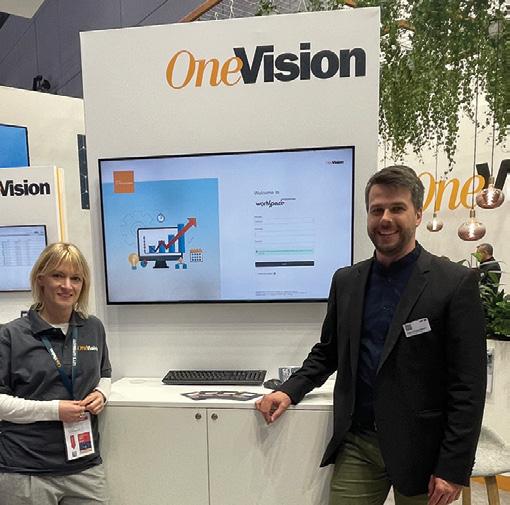
OneVision Amendo AI maximizes productivity with fast image processing and optimization. Amendo optimizes images based on object classes (indoor, outdoor, skin tones etc.) scales images to new dimensions, with color management and/or format conversion.

Diversified Nano Solutions Corp (DNSC) produces specialty inkjet inks including invisible, MICR, UV Fluorescent and biometric. Its new trademarked product Inkcrypt AR Ink Solutions is a DNA biomarker technology for ink and fluids that provides authentication, tracking and counterfeit protection.

Esko ArtPro+ provides native PDF editing, especially for packaging prepress applications. It’s rich feature set includes automated layout creation and trapping, imposition for labels, flexibles and folding cartons, text recognition and non-destructive warping to compensate for distortions.
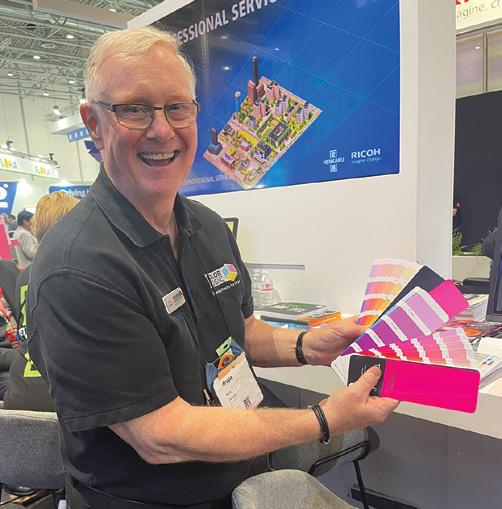
Touch7 Neon Color System is the first accurate color system for neon/fluorescent colors--whether you use inks or toners, digital or conventional printing. With the Touch7 system, printers can produce swatch books on their own press and take advantage of their device gamut.
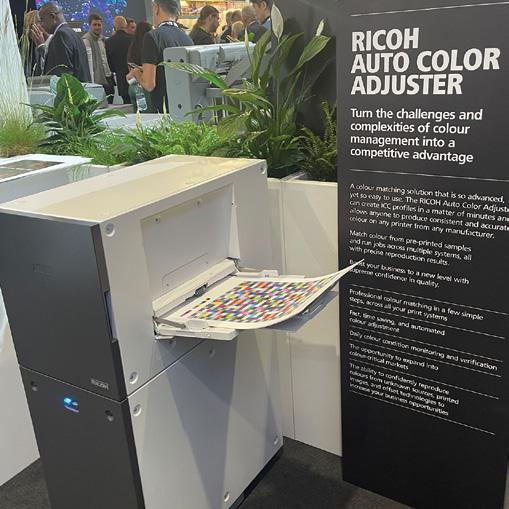
RICOH Auto Color Adjuster is a high-speed colorimetric device that automates color matching, without the intervention of a colormanagement specialist. The system can create ICC profiles quickly for different printer models, for precise matching when moving work from device to device.

Letternart Henrich Weusthoff is a German artist who creates works of art from antique wood and metal typefaces, dingbats, woodcuts, and engravings. Each creation is one-of-a-kind and comes in all shapes and sizes. If you love print, you will love these unique pieces of art.
BY STEVE JOHNSON
In my dual roles as CEO of a printing company and as a journalist covering the graphic arts, I receive a lot of marketing mail. Much of it is pretty good, and every now and then I receive a piece that is outstanding.
Today I’d like to tip my hat to some direct mail marketing efforts that could have settled for being good, but instead went the extra mile to achieve greatness.
My business mail is processed by our accounting department, who apply a quick and efficient sorting procedure that includes liberal use of a wastebasket and a shredder.
When my bookkeeper, with no prior print experience, hand delivers a mail piece to me while exclaiming “this is amazing” or “you’ve gotta see this!” I know we’ve found a winner.
Müller Martini is a three-quarter-century old European manufacturer of bookbinding machinery. When you are selling bindery equipment, it might make sense to show off your binding prowess. Such was the case with the pre-drupa piece I received, folded in such an elaborate manner as to baffle me as to how it was done.

The fancy folds drew me in, but so did the photos of machines that were of interest to my business. Was it personalized using variable data? It doesn’t really matter how it was done, because it felt personalized to me.
Once I unfolded the piece (how could I resist?) a short message and a QR code invited me to register for drupa. Not going to drupa? A side note invited me to attend Hunkeler Innovationdays next February.
One way or another, Müller Martini is determined to get me to a show.
Most paper ads look pretty much the same. Beautiful, yes, but the same. Case Paper apparently realized this, so they broke the mold and pulled out all the stops for their 80th anniversary mailer.
The timelinethemed piece, a saddle-bound oblong book, contained every possible fold, die-cut, embellishment, and coating known to man…but wait, there’s more.
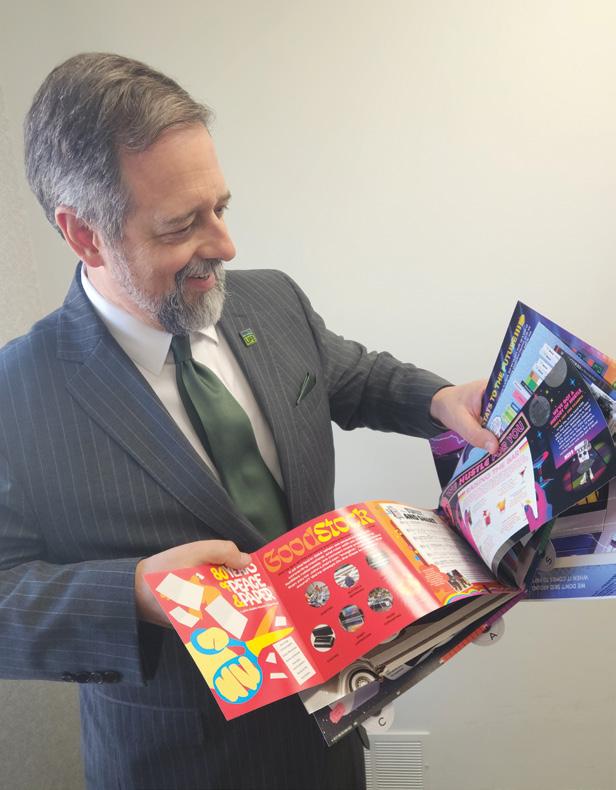
In this era of one-sentence tweets, paper merchant Case has rolled out (pun intended) a 12-page booklet overflowing with copy, every sentence containing a paper-related pun. It takes a half hour to read the thing in its entirety, partly because there is so much text and partly because you’ll stop every minute to examine and admire the print and finishing techniques.
Case Paper knows we’re not currently buying from them, so they’ve made sure we’ll think of them the next time we order paper.
As a rule I detest email advertising. I’m bombarded with spam, and I make great use of filters to thin out my inbox. Based upon this, it should come as quite a surprise that I read Dave Lewis’ Snailworks email newsletter.
I should be appalled that a company that earns its profits from direct mailing sends its newsletter via email. The email is unsolicited (I never subscribed), a practice I deplore. To top it off, I’m not even in the direct mailing business.
The catch is that the newsletter is so darn interesting. Short and sweet, arriving infrequently, these little email missives always contain informative and useful information about the performance of the United States Postal Service.
Brutally honest, chock full of data, I can’t help opening and reading these emails.
Snailworks has discovered that great content and useful information succeed with me every time.
For goodness’ sake, try something different! Put some extra effort into your marketing, and I just might be tipping my hat to you.


